Implementation of ERP system in Sichuan Jiuzhou Electronic Co., Ltd.
VerifiedAdded on 2023/04/23
|34
|5531
|264
AI Summary
This report provides an implementation guide for implementing the CRM system in the Sichuan Jiuzhou Electronic Co Ltd. Here a seven-step process has been identified and analyzed for implementing the system for the organization. In the seven-step SDLC, each and every process has been properly discussed and each and every activity required has been clearly mentioned in the report for developing a comprehensive implementation guide.
Contribute Materials
Your contribution can guide someone’s learning journey. Share your
documents today.

Implementation of ERP system
Project report
Implementation of ERP system
Author’s Note
Project report
Implementation of ERP system
Author’s Note
Secure Best Marks with AI Grader
Need help grading? Try our AI Grader for instant feedback on your assignments.
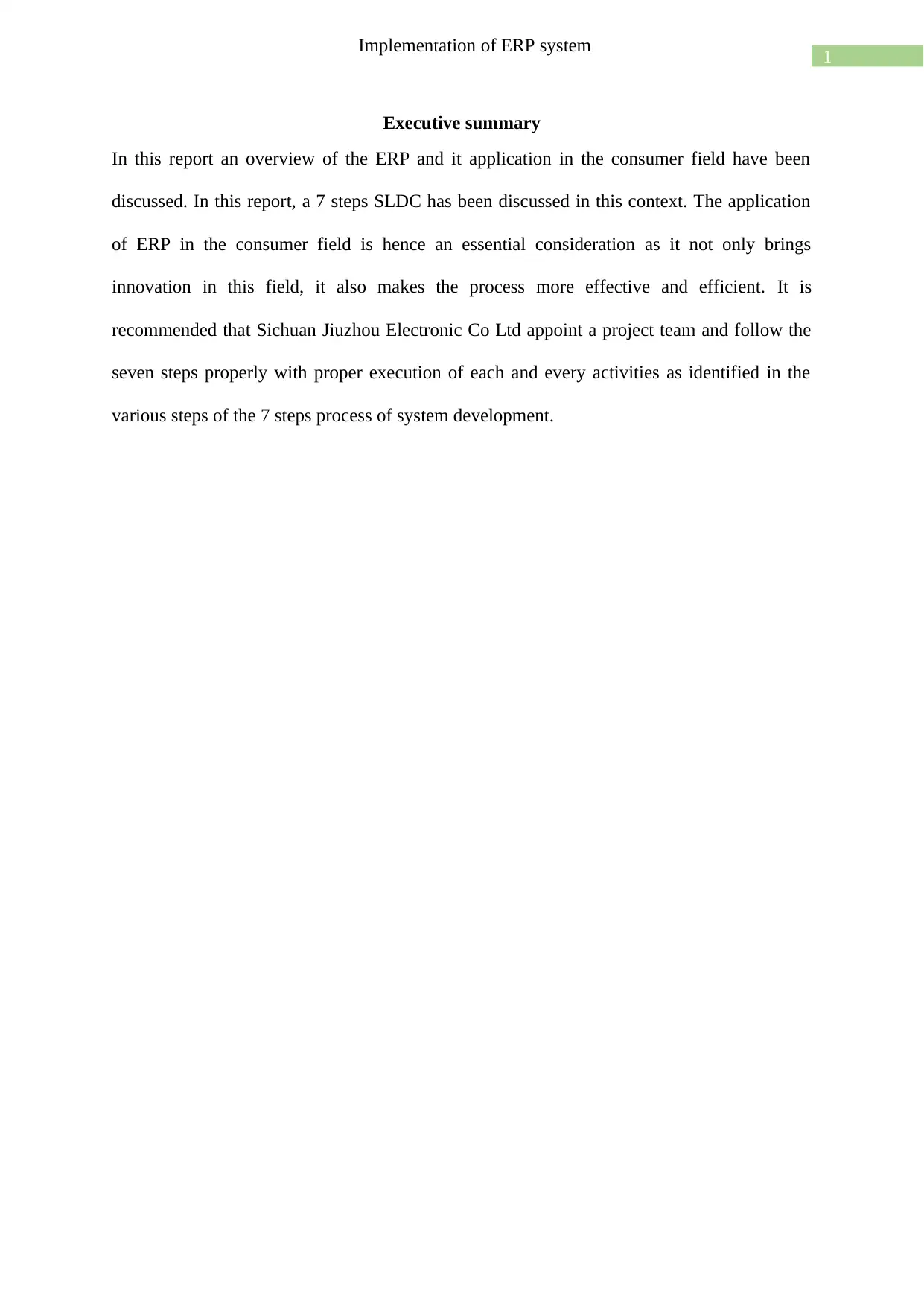
1
Implementation of ERP system
Executive summary
In this report an overview of the ERP and it application in the consumer field have been
discussed. In this report, a 7 steps SLDC has been discussed in this context. The application
of ERP in the consumer field is hence an essential consideration as it not only brings
innovation in this field, it also makes the process more effective and efficient. It is
recommended that Sichuan Jiuzhou Electronic Co Ltd appoint a project team and follow the
seven steps properly with proper execution of each and every activities as identified in the
various steps of the 7 steps process of system development.
Implementation of ERP system
Executive summary
In this report an overview of the ERP and it application in the consumer field have been
discussed. In this report, a 7 steps SLDC has been discussed in this context. The application
of ERP in the consumer field is hence an essential consideration as it not only brings
innovation in this field, it also makes the process more effective and efficient. It is
recommended that Sichuan Jiuzhou Electronic Co Ltd appoint a project team and follow the
seven steps properly with proper execution of each and every activities as identified in the
various steps of the 7 steps process of system development.
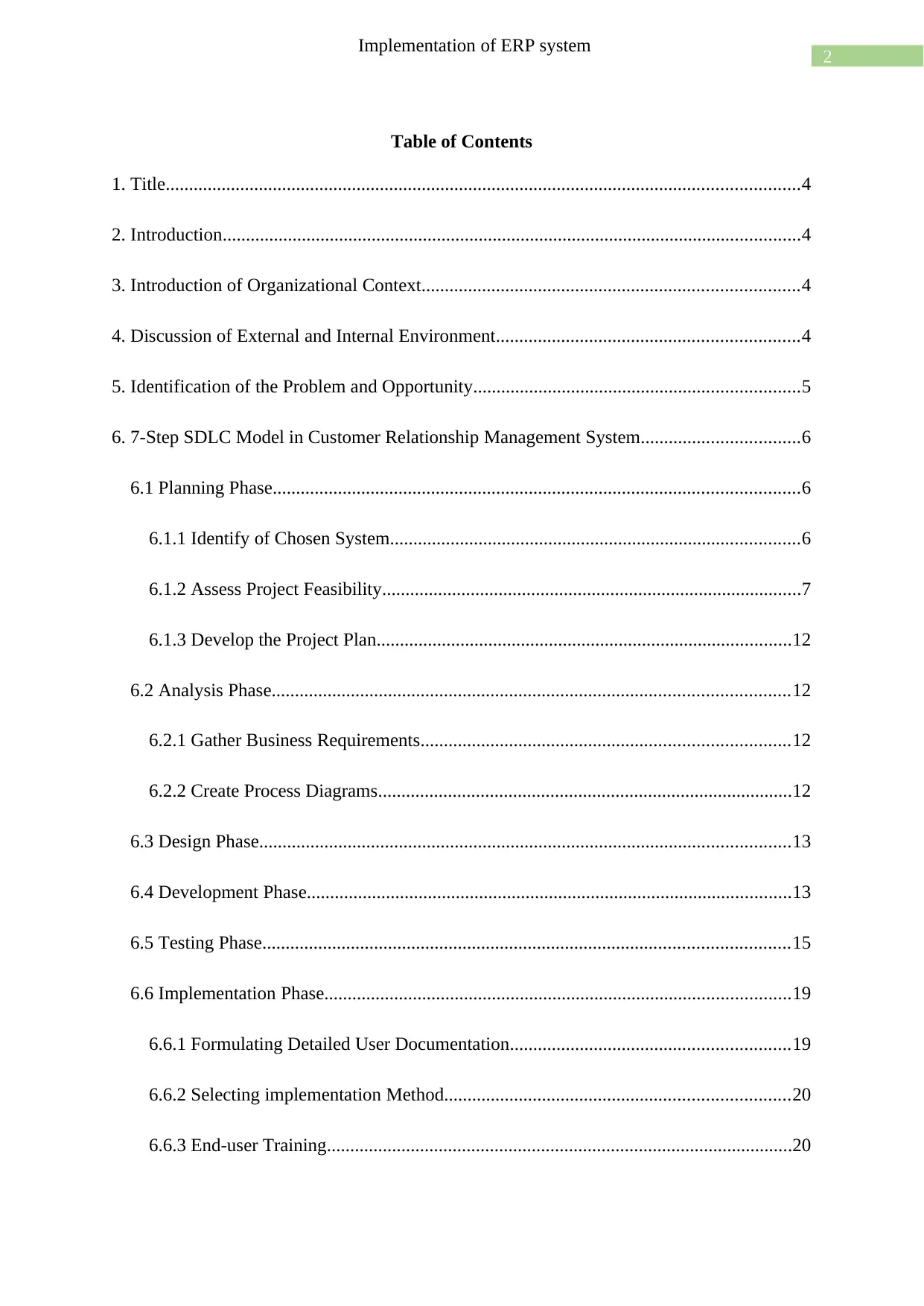
2
Implementation of ERP system
Table of Contents
1. Title........................................................................................................................................4
2. Introduction............................................................................................................................4
3. Introduction of Organizational Context.................................................................................4
4. Discussion of External and Internal Environment.................................................................4
5. Identification of the Problem and Opportunity......................................................................5
6. 7-Step SDLC Model in Customer Relationship Management System..................................6
6.1 Planning Phase.................................................................................................................6
6.1.1 Identify of Chosen System........................................................................................6
6.1.2 Assess Project Feasibility..........................................................................................7
6.1.3 Develop the Project Plan.........................................................................................12
6.2 Analysis Phase...............................................................................................................12
6.2.1 Gather Business Requirements...............................................................................12
6.2.2 Create Process Diagrams.........................................................................................12
6.3 Design Phase..................................................................................................................13
6.4 Development Phase........................................................................................................13
6.5 Testing Phase.................................................................................................................15
6.6 Implementation Phase....................................................................................................19
6.6.1 Formulating Detailed User Documentation............................................................19
6.6.2 Selecting implementation Method..........................................................................20
6.6.3 End-user Training....................................................................................................20
Implementation of ERP system
Table of Contents
1. Title........................................................................................................................................4
2. Introduction............................................................................................................................4
3. Introduction of Organizational Context.................................................................................4
4. Discussion of External and Internal Environment.................................................................4
5. Identification of the Problem and Opportunity......................................................................5
6. 7-Step SDLC Model in Customer Relationship Management System..................................6
6.1 Planning Phase.................................................................................................................6
6.1.1 Identify of Chosen System........................................................................................6
6.1.2 Assess Project Feasibility..........................................................................................7
6.1.3 Develop the Project Plan.........................................................................................12
6.2 Analysis Phase...............................................................................................................12
6.2.1 Gather Business Requirements...............................................................................12
6.2.2 Create Process Diagrams.........................................................................................12
6.3 Design Phase..................................................................................................................13
6.4 Development Phase........................................................................................................13
6.5 Testing Phase.................................................................................................................15
6.6 Implementation Phase....................................................................................................19
6.6.1 Formulating Detailed User Documentation............................................................19
6.6.2 Selecting implementation Method..........................................................................20
6.6.3 End-user Training....................................................................................................20
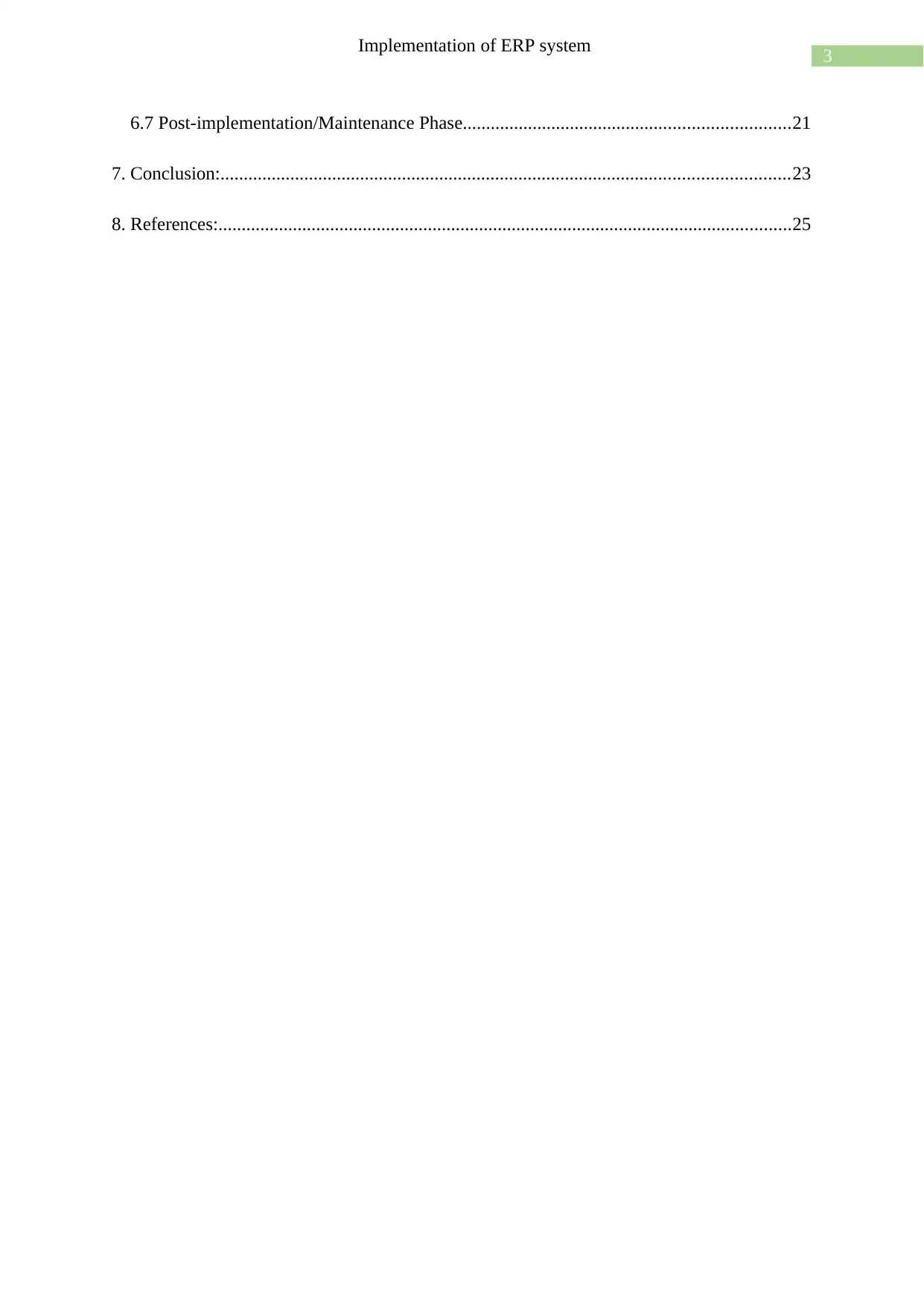
3
Implementation of ERP system
6.7 Post-implementation/Maintenance Phase......................................................................21
7. Conclusion:..........................................................................................................................23
8. References:...........................................................................................................................25
Implementation of ERP system
6.7 Post-implementation/Maintenance Phase......................................................................21
7. Conclusion:..........................................................................................................................23
8. References:...........................................................................................................................25
Secure Best Marks with AI Grader
Need help grading? Try our AI Grader for instant feedback on your assignments.
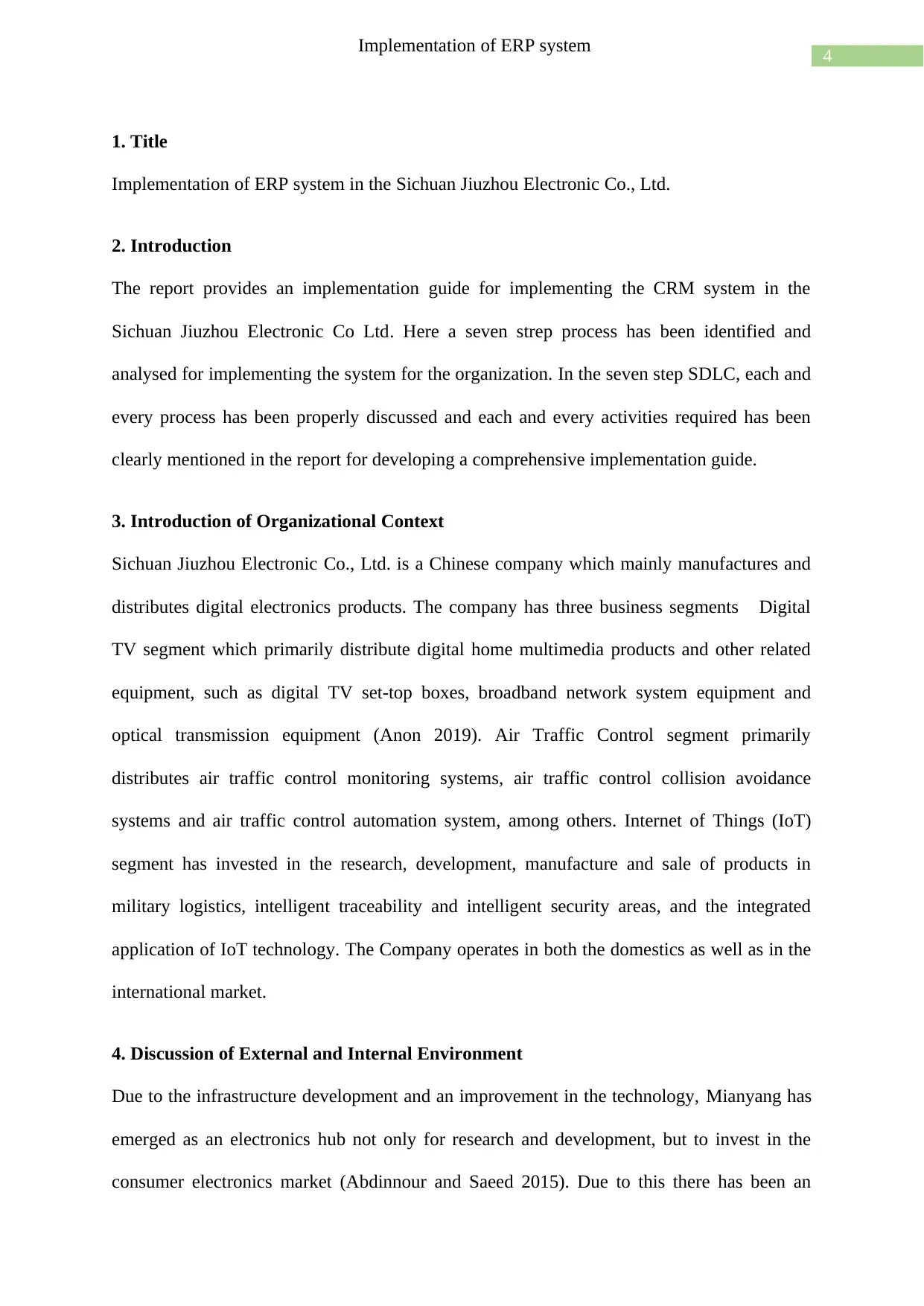
4
Implementation of ERP system
1. Title
Implementation of ERP system in the Sichuan Jiuzhou Electronic Co., Ltd.
2. Introduction
The report provides an implementation guide for implementing the CRM system in the
Sichuan Jiuzhou Electronic Co Ltd. Here a seven strep process has been identified and
analysed for implementing the system for the organization. In the seven step SDLC, each and
every process has been properly discussed and each and every activities required has been
clearly mentioned in the report for developing a comprehensive implementation guide.
3. Introduction of Organizational Context
Sichuan Jiuzhou Electronic Co., Ltd. is a Chinese company which mainly manufactures and
distributes digital electronics products. The company has three business segments Digital
TV segment which primarily distribute digital home multimedia products and other related
equipment, such as digital TV set-top boxes, broadband network system equipment and
optical transmission equipment (Anon 2019). Air Traffic Control segment primarily
distributes air traffic control monitoring systems, air traffic control collision avoidance
systems and air traffic control automation system, among others. Internet of Things (IoT)
segment has invested in the research, development, manufacture and sale of products in
military logistics, intelligent traceability and intelligent security areas, and the integrated
application of IoT technology. The Company operates in both the domestics as well as in the
international market.
4. Discussion of External and Internal Environment
Due to the infrastructure development and an improvement in the technology, Mianyang has
emerged as an electronics hub not only for research and development, but to invest in the
consumer electronics market (Abdinnour and Saeed 2015). Due to this there has been an
Implementation of ERP system
1. Title
Implementation of ERP system in the Sichuan Jiuzhou Electronic Co., Ltd.
2. Introduction
The report provides an implementation guide for implementing the CRM system in the
Sichuan Jiuzhou Electronic Co Ltd. Here a seven strep process has been identified and
analysed for implementing the system for the organization. In the seven step SDLC, each and
every process has been properly discussed and each and every activities required has been
clearly mentioned in the report for developing a comprehensive implementation guide.
3. Introduction of Organizational Context
Sichuan Jiuzhou Electronic Co., Ltd. is a Chinese company which mainly manufactures and
distributes digital electronics products. The company has three business segments Digital
TV segment which primarily distribute digital home multimedia products and other related
equipment, such as digital TV set-top boxes, broadband network system equipment and
optical transmission equipment (Anon 2019). Air Traffic Control segment primarily
distributes air traffic control monitoring systems, air traffic control collision avoidance
systems and air traffic control automation system, among others. Internet of Things (IoT)
segment has invested in the research, development, manufacture and sale of products in
military logistics, intelligent traceability and intelligent security areas, and the integrated
application of IoT technology. The Company operates in both the domestics as well as in the
international market.
4. Discussion of External and Internal Environment
Due to the infrastructure development and an improvement in the technology, Mianyang has
emerged as an electronics hub not only for research and development, but to invest in the
consumer electronics market (Abdinnour and Saeed 2015). Due to this there has been an

5
Implementation of ERP system
increase in the number of consumer Electronics Company which operates out of Mianyang.
Hence there is a strong consumer bargain in the market due to lot of product availability.
Hence in order to maintain an effective market position, Sichuan Jiuzhou Electronic Co., Ltd.
needs to recognize this competition (Abu-Shanab, Abu-Shehab and Khairallah 2015).
Sichuan Jiuzhou Electronic Co., Ltd. needs to first recognize this domestic competition to
excel in the international market. In order to do this the organization needs close assessment
of its strength and weakness and innovate accordingly through effective product delivery and
consumer service.
5. Identification of the Problem and Opportunity
Problems:
Strong market completion
Strong consumer bargain power
Proper consumer service
Opportunities:
Create a strong market position and retain it
Attract a lot of consumer for developing strong consumer base
Maximizing profit through effective product distribution
Increasing brand value and retaining consumer
Expanding in the international market
Implementation of ERP system
increase in the number of consumer Electronics Company which operates out of Mianyang.
Hence there is a strong consumer bargain in the market due to lot of product availability.
Hence in order to maintain an effective market position, Sichuan Jiuzhou Electronic Co., Ltd.
needs to recognize this competition (Abu-Shanab, Abu-Shehab and Khairallah 2015).
Sichuan Jiuzhou Electronic Co., Ltd. needs to first recognize this domestic competition to
excel in the international market. In order to do this the organization needs close assessment
of its strength and weakness and innovate accordingly through effective product delivery and
consumer service.
5. Identification of the Problem and Opportunity
Problems:
Strong market completion
Strong consumer bargain power
Proper consumer service
Opportunities:
Create a strong market position and retain it
Attract a lot of consumer for developing strong consumer base
Maximizing profit through effective product distribution
Increasing brand value and retaining consumer
Expanding in the international market
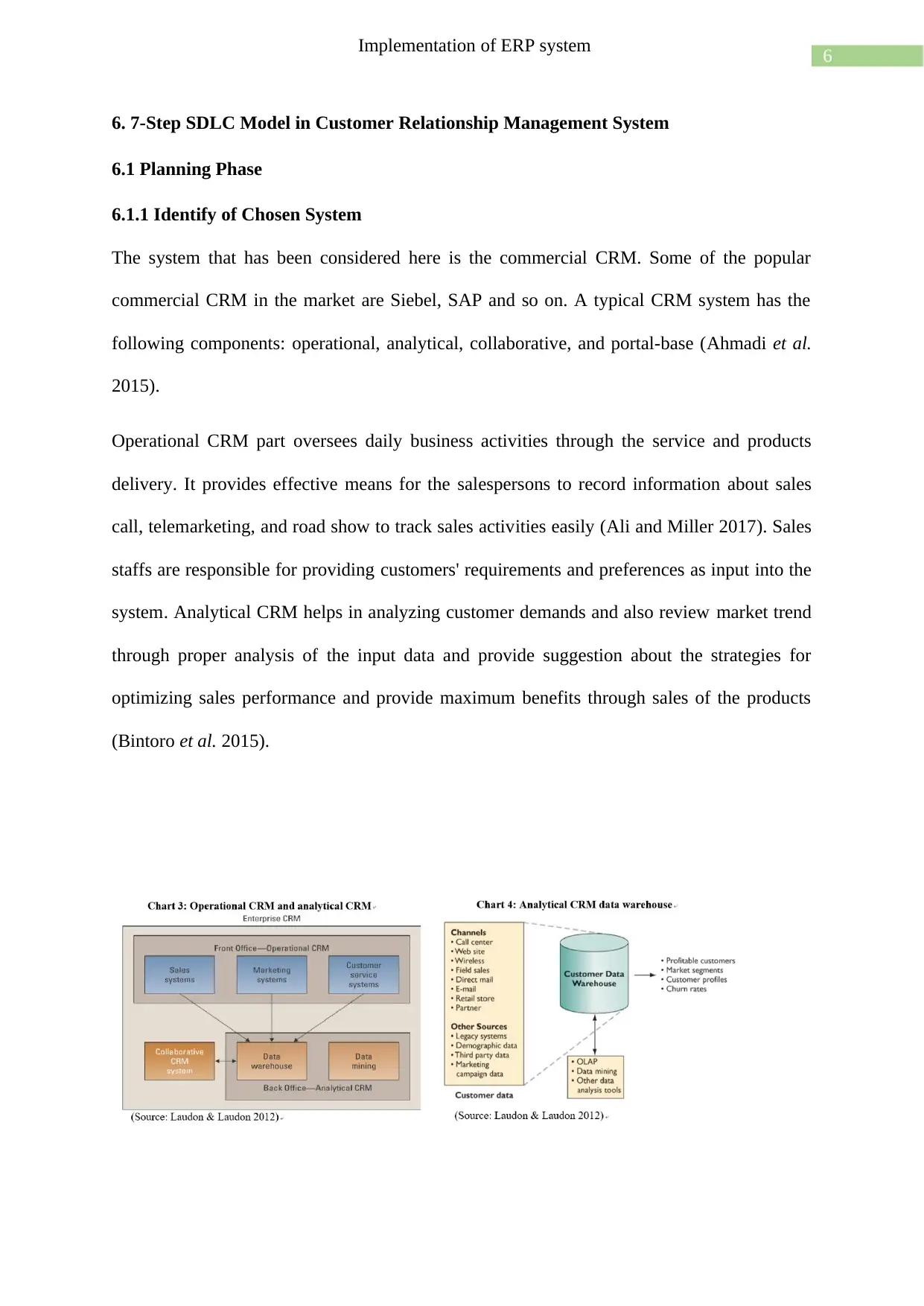
6
Implementation of ERP system
6. 7-Step SDLC Model in Customer Relationship Management System
6.1 Planning Phase
6.1.1 Identify of Chosen System
The system that has been considered here is the commercial CRM. Some of the popular
commercial CRM in the market are Siebel, SAP and so on. A typical CRM system has the
following components: operational, analytical, collaborative, and portal-base (Ahmadi et al.
2015).
Operational CRM part oversees daily business activities through the service and products
delivery. It provides effective means for the salespersons to record information about sales
call, telemarketing, and road show to track sales activities easily (Ali and Miller 2017). Sales
staffs are responsible for providing customers' requirements and preferences as input into the
system. Analytical CRM helps in analyzing customer demands and also review market trend
through proper analysis of the input data and provide suggestion about the strategies for
optimizing sales performance and provide maximum benefits through sales of the products
(Bintoro et al. 2015).
Implementation of ERP system
6. 7-Step SDLC Model in Customer Relationship Management System
6.1 Planning Phase
6.1.1 Identify of Chosen System
The system that has been considered here is the commercial CRM. Some of the popular
commercial CRM in the market are Siebel, SAP and so on. A typical CRM system has the
following components: operational, analytical, collaborative, and portal-base (Ahmadi et al.
2015).
Operational CRM part oversees daily business activities through the service and products
delivery. It provides effective means for the salespersons to record information about sales
call, telemarketing, and road show to track sales activities easily (Ali and Miller 2017). Sales
staffs are responsible for providing customers' requirements and preferences as input into the
system. Analytical CRM helps in analyzing customer demands and also review market trend
through proper analysis of the input data and provide suggestion about the strategies for
optimizing sales performance and provide maximum benefits through sales of the products
(Bintoro et al. 2015).
Paraphrase This Document
Need a fresh take? Get an instant paraphrase of this document with our AI Paraphraser
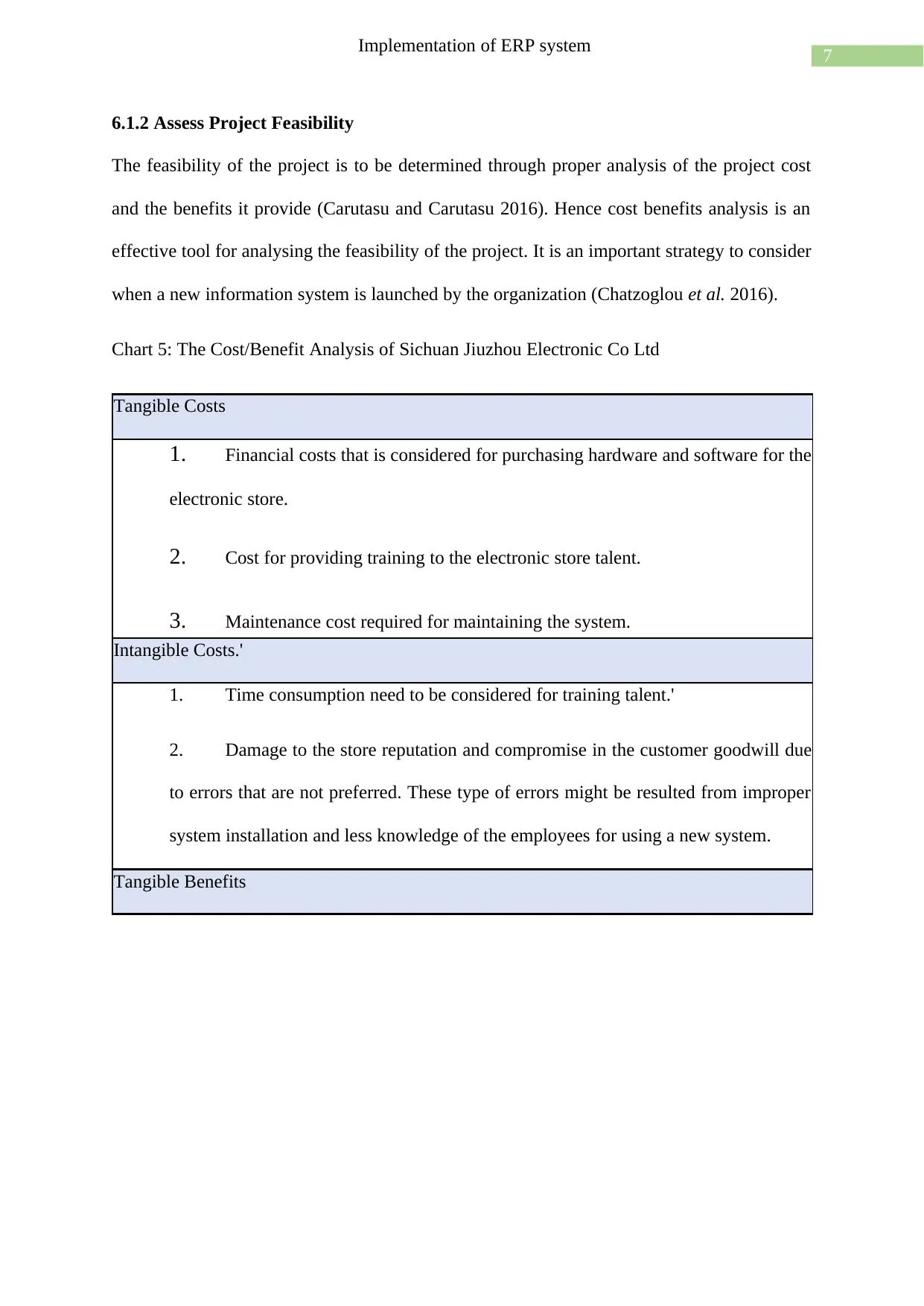
7
Implementation of ERP system
6.1.2 Assess Project Feasibility
The feasibility of the project is to be determined through proper analysis of the project cost
and the benefits it provide (Carutasu and Carutasu 2016). Hence cost benefits analysis is an
effective tool for analysing the feasibility of the project. It is an important strategy to consider
when a new information system is launched by the organization (Chatzoglou et al. 2016).
Chart 5: The Cost/Benefit Analysis of Sichuan Jiuzhou Electronic Co Ltd
Tangible Costs
1. Financial costs that is considered for purchasing hardware and software for the
electronic store.
2. Cost for providing training to the electronic store talent.
3. Maintenance cost required for maintaining the system.
Intangible Costs.'
1. Time consumption need to be considered for training talent.'
2. Damage to the store reputation and compromise in the customer goodwill due
to errors that are not preferred. These type of errors might be resulted from improper
system installation and less knowledge of the employees for using a new system.
Tangible Benefits
Implementation of ERP system
6.1.2 Assess Project Feasibility
The feasibility of the project is to be determined through proper analysis of the project cost
and the benefits it provide (Carutasu and Carutasu 2016). Hence cost benefits analysis is an
effective tool for analysing the feasibility of the project. It is an important strategy to consider
when a new information system is launched by the organization (Chatzoglou et al. 2016).
Chart 5: The Cost/Benefit Analysis of Sichuan Jiuzhou Electronic Co Ltd
Tangible Costs
1. Financial costs that is considered for purchasing hardware and software for the
electronic store.
2. Cost for providing training to the electronic store talent.
3. Maintenance cost required for maintaining the system.
Intangible Costs.'
1. Time consumption need to be considered for training talent.'
2. Damage to the store reputation and compromise in the customer goodwill due
to errors that are not preferred. These type of errors might be resulted from improper
system installation and less knowledge of the employees for using a new system.
Tangible Benefits

8
Implementation of ERP system
1. Increasing in the hotel sales and profits with proper analysis of customer
needs through appropriate knowledge.
2. Reduction in the costs required for the information processing.
3. Reduction in the operating cost.
4. Improvement in the working efficiency with proper utilization of the digital
technology in the store.
Intangible Benefits
1. Improvement and enhancement in the quality of the customer service
provided.
2. Improvement in the information availability through data mining.
3. Improvement in the reputation of the electronic store through proper customer
relationship.
Cost-Benefit - INPUT VALUES
Hardware
$ 28,000.00
Software
$ 40,000.00
Development team salaries
$ 8,000.00
Training
$ 9,500.00
Total Development Cost
$ 85,500.00
Hardware
$ 30,000.00
Software
$ 10,000.00
Operational labour $ 10,065.00
Implementation of ERP system
1. Increasing in the hotel sales and profits with proper analysis of customer
needs through appropriate knowledge.
2. Reduction in the costs required for the information processing.
3. Reduction in the operating cost.
4. Improvement in the working efficiency with proper utilization of the digital
technology in the store.
Intangible Benefits
1. Improvement and enhancement in the quality of the customer service
provided.
2. Improvement in the information availability through data mining.
3. Improvement in the reputation of the electronic store through proper customer
relationship.
Cost-Benefit - INPUT VALUES
Hardware
$ 28,000.00
Software
$ 40,000.00
Development team salaries
$ 8,000.00
Training
$ 9,500.00
Total Development Cost
$ 85,500.00
Hardware
$ 30,000.00
Software
$ 10,000.00
Operational labour $ 10,065.00
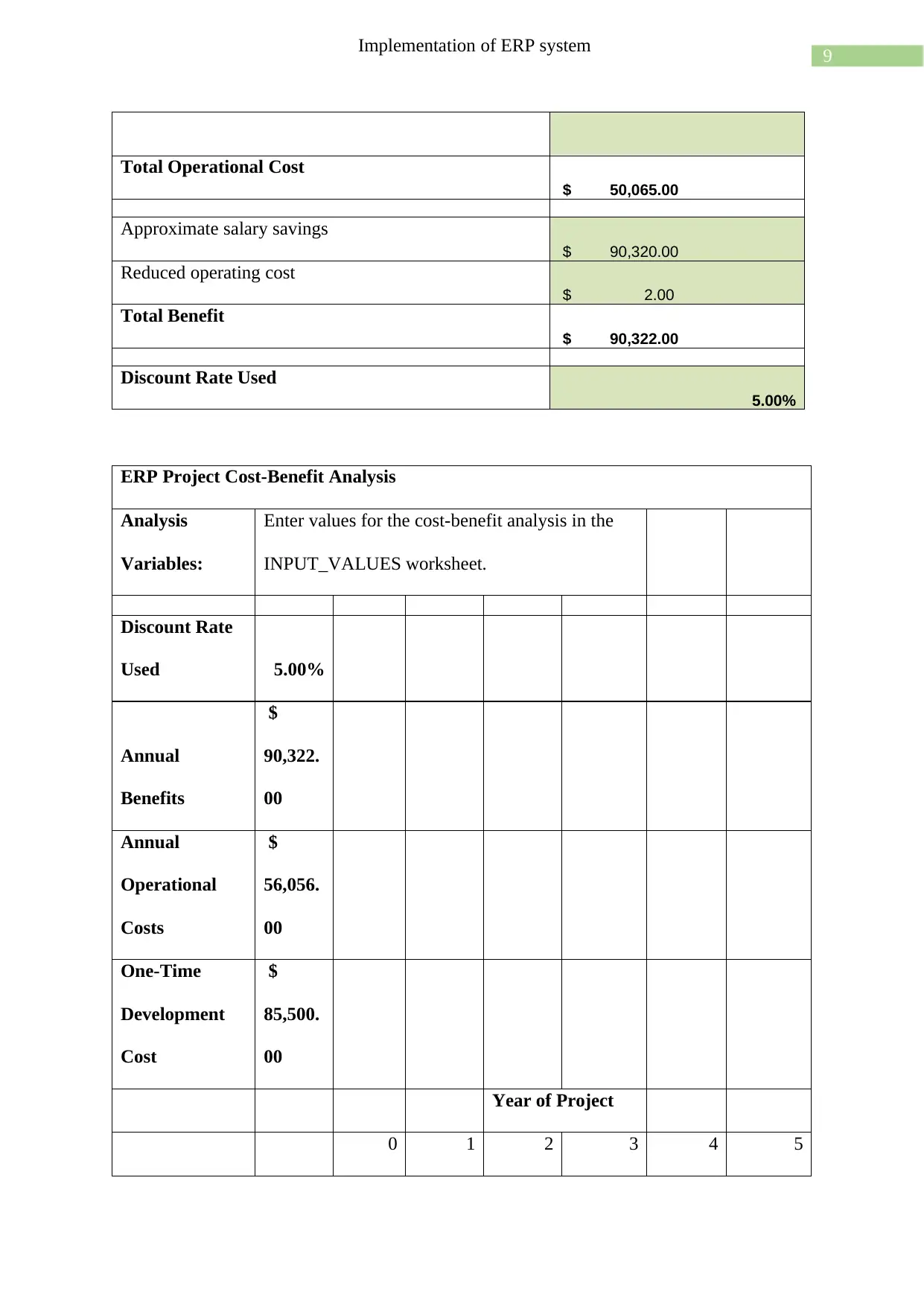
9
Implementation of ERP system
Total Operational Cost
$ 50,065.00
Approximate salary savings
$ 90,320.00
Reduced operating cost
$ 2.00
Total Benefit
$ 90,322.00
Discount Rate Used
5.00%
ERP Project Cost-Benefit Analysis
Analysis
Variables:
Enter values for the cost-benefit analysis in the
INPUT_VALUES worksheet.
Discount Rate
Used 5.00%
Annual
Benefits
$
90,322.
00
Annual
Operational
Costs
$
56,056.
00
One-Time
Development
Cost
$
85,500.
00
Year of Project
0 1 2 3 4 5
Implementation of ERP system
Total Operational Cost
$ 50,065.00
Approximate salary savings
$ 90,320.00
Reduced operating cost
$ 2.00
Total Benefit
$ 90,322.00
Discount Rate Used
5.00%
ERP Project Cost-Benefit Analysis
Analysis
Variables:
Enter values for the cost-benefit analysis in the
INPUT_VALUES worksheet.
Discount Rate
Used 5.00%
Annual
Benefits
$
90,322.
00
Annual
Operational
Costs
$
56,056.
00
One-Time
Development
Cost
$
85,500.
00
Year of Project
0 1 2 3 4 5
Secure Best Marks with AI Grader
Need help grading? Try our AI Grader for instant feedback on your assignments.
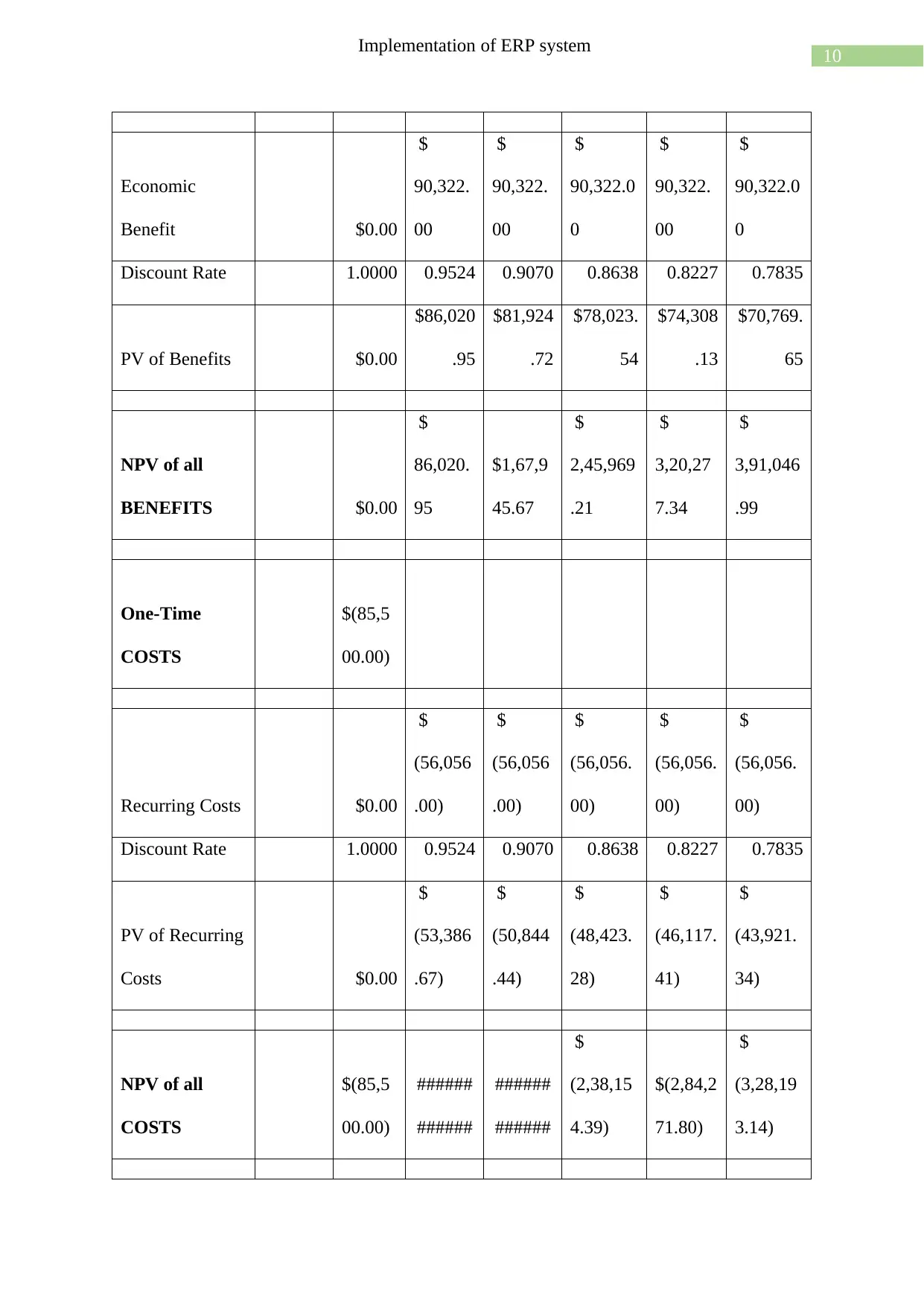
10
Implementation of ERP system
Economic
Benefit $0.00
$
90,322.
00
$
90,322.
00
$
90,322.0
0
$
90,322.
00
$
90,322.0
0
Discount Rate 1.0000 0.9524 0.9070 0.8638 0.8227 0.7835
PV of Benefits $0.00
$86,020
.95
$81,924
.72
$78,023.
54
$74,308
.13
$70,769.
65
NPV of all
BENEFITS $0.00
$
86,020.
95
$1,67,9
45.67
$
2,45,969
.21
$
3,20,27
7.34
$
3,91,046
.99
One-Time
COSTS
$(85,5
00.00)
Recurring Costs $0.00
$
(56,056
.00)
$
(56,056
.00)
$
(56,056.
00)
$
(56,056.
00)
$
(56,056.
00)
Discount Rate 1.0000 0.9524 0.9070 0.8638 0.8227 0.7835
PV of Recurring
Costs $0.00
$
(53,386
.67)
$
(50,844
.44)
$
(48,423.
28)
$
(46,117.
41)
$
(43,921.
34)
NPV of all
COSTS
$(85,5
00.00)
######
######
######
######
$
(2,38,15
4.39)
$(2,84,2
71.80)
$
(3,28,19
3.14)
Implementation of ERP system
Economic
Benefit $0.00
$
90,322.
00
$
90,322.
00
$
90,322.0
0
$
90,322.
00
$
90,322.0
0
Discount Rate 1.0000 0.9524 0.9070 0.8638 0.8227 0.7835
PV of Benefits $0.00
$86,020
.95
$81,924
.72
$78,023.
54
$74,308
.13
$70,769.
65
NPV of all
BENEFITS $0.00
$
86,020.
95
$1,67,9
45.67
$
2,45,969
.21
$
3,20,27
7.34
$
3,91,046
.99
One-Time
COSTS
$(85,5
00.00)
Recurring Costs $0.00
$
(56,056
.00)
$
(56,056
.00)
$
(56,056.
00)
$
(56,056.
00)
$
(56,056.
00)
Discount Rate 1.0000 0.9524 0.9070 0.8638 0.8227 0.7835
PV of Recurring
Costs $0.00
$
(53,386
.67)
$
(50,844
.44)
$
(48,423.
28)
$
(46,117.
41)
$
(43,921.
34)
NPV of all
COSTS
$(85,5
00.00)
######
######
######
######
$
(2,38,15
4.39)
$(2,84,2
71.80)
$
(3,28,19
3.14)
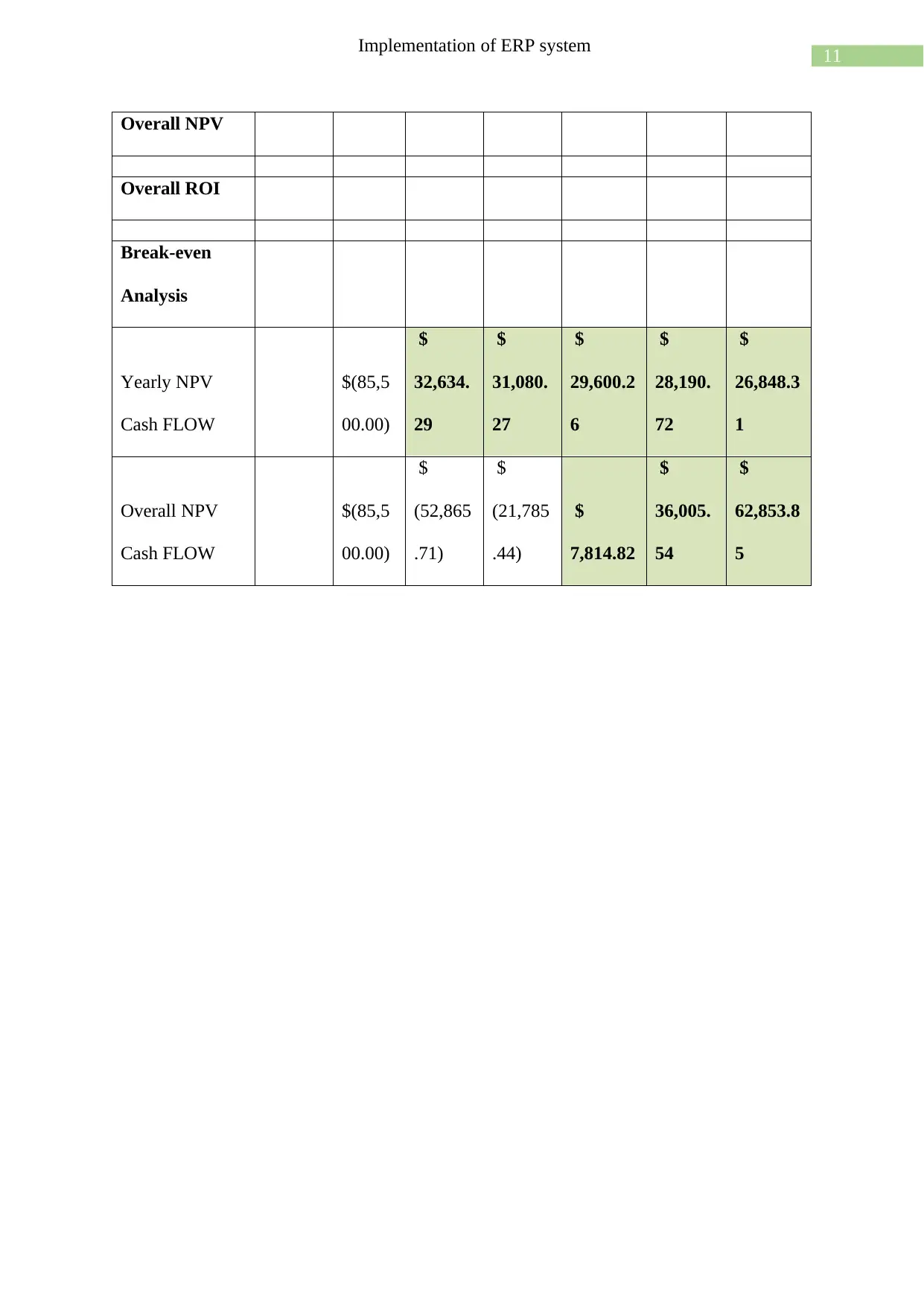
11
Implementation of ERP system
Overall NPV
Overall ROI
Break-even
Analysis
Yearly NPV
Cash FLOW
$(85,5
00.00)
$
32,634.
29
$
31,080.
27
$
29,600.2
6
$
28,190.
72
$
26,848.3
1
Overall NPV
Cash FLOW
$(85,5
00.00)
$
(52,865
.71)
$
(21,785
.44)
$
7,814.82
$
36,005.
54
$
62,853.8
5
Implementation of ERP system
Overall NPV
Overall ROI
Break-even
Analysis
Yearly NPV
Cash FLOW
$(85,5
00.00)
$
32,634.
29
$
31,080.
27
$
29,600.2
6
$
28,190.
72
$
26,848.3
1
Overall NPV
Cash FLOW
$(85,5
00.00)
$
(52,865
.71)
$
(21,785
.44)
$
7,814.82
$
36,005.
54
$
62,853.8
5
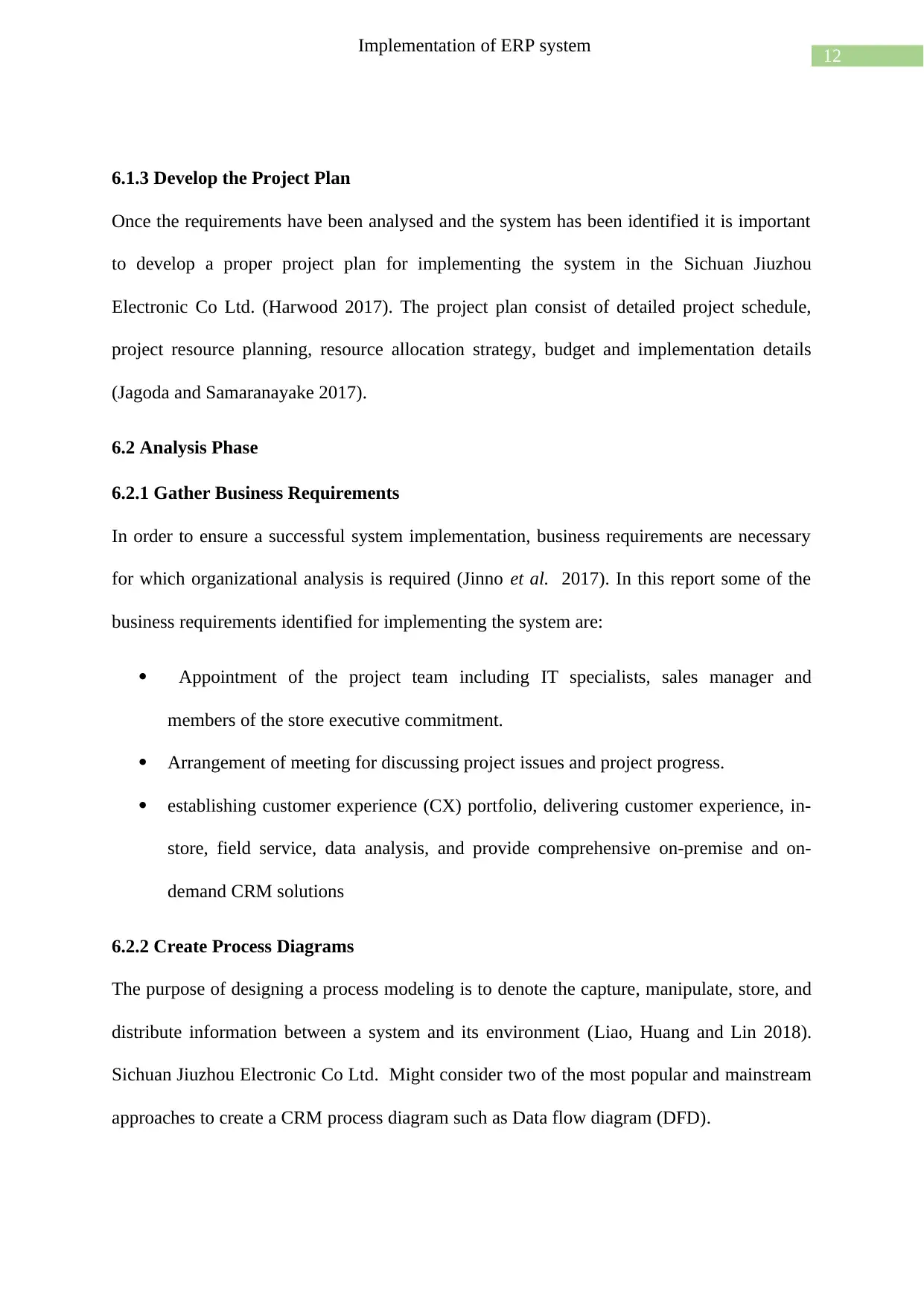
12
Implementation of ERP system
6.1.3 Develop the Project Plan
Once the requirements have been analysed and the system has been identified it is important
to develop a proper project plan for implementing the system in the Sichuan Jiuzhou
Electronic Co Ltd. (Harwood 2017). The project plan consist of detailed project schedule,
project resource planning, resource allocation strategy, budget and implementation details
(Jagoda and Samaranayake 2017).
6.2 Analysis Phase
6.2.1 Gather Business Requirements
In order to ensure a successful system implementation, business requirements are necessary
for which organizational analysis is required (Jinno et al. 2017). In this report some of the
business requirements identified for implementing the system are:
Appointment of the project team including IT specialists, sales manager and
members of the store executive commitment.
Arrangement of meeting for discussing project issues and project progress.
establishing customer experience (CX) portfolio, delivering customer experience, in-
store, field service, data analysis, and provide comprehensive on-premise and on-
demand CRM solutions
6.2.2 Create Process Diagrams
The purpose of designing a process modeling is to denote the capture, manipulate, store, and
distribute information between a system and its environment (Liao, Huang and Lin 2018).
Sichuan Jiuzhou Electronic Co Ltd. Might consider two of the most popular and mainstream
approaches to create a CRM process diagram such as Data flow diagram (DFD).
Implementation of ERP system
6.1.3 Develop the Project Plan
Once the requirements have been analysed and the system has been identified it is important
to develop a proper project plan for implementing the system in the Sichuan Jiuzhou
Electronic Co Ltd. (Harwood 2017). The project plan consist of detailed project schedule,
project resource planning, resource allocation strategy, budget and implementation details
(Jagoda and Samaranayake 2017).
6.2 Analysis Phase
6.2.1 Gather Business Requirements
In order to ensure a successful system implementation, business requirements are necessary
for which organizational analysis is required (Jinno et al. 2017). In this report some of the
business requirements identified for implementing the system are:
Appointment of the project team including IT specialists, sales manager and
members of the store executive commitment.
Arrangement of meeting for discussing project issues and project progress.
establishing customer experience (CX) portfolio, delivering customer experience, in-
store, field service, data analysis, and provide comprehensive on-premise and on-
demand CRM solutions
6.2.2 Create Process Diagrams
The purpose of designing a process modeling is to denote the capture, manipulate, store, and
distribute information between a system and its environment (Liao, Huang and Lin 2018).
Sichuan Jiuzhou Electronic Co Ltd. Might consider two of the most popular and mainstream
approaches to create a CRM process diagram such as Data flow diagram (DFD).
Paraphrase This Document
Need a fresh take? Get an instant paraphrase of this document with our AI Paraphraser
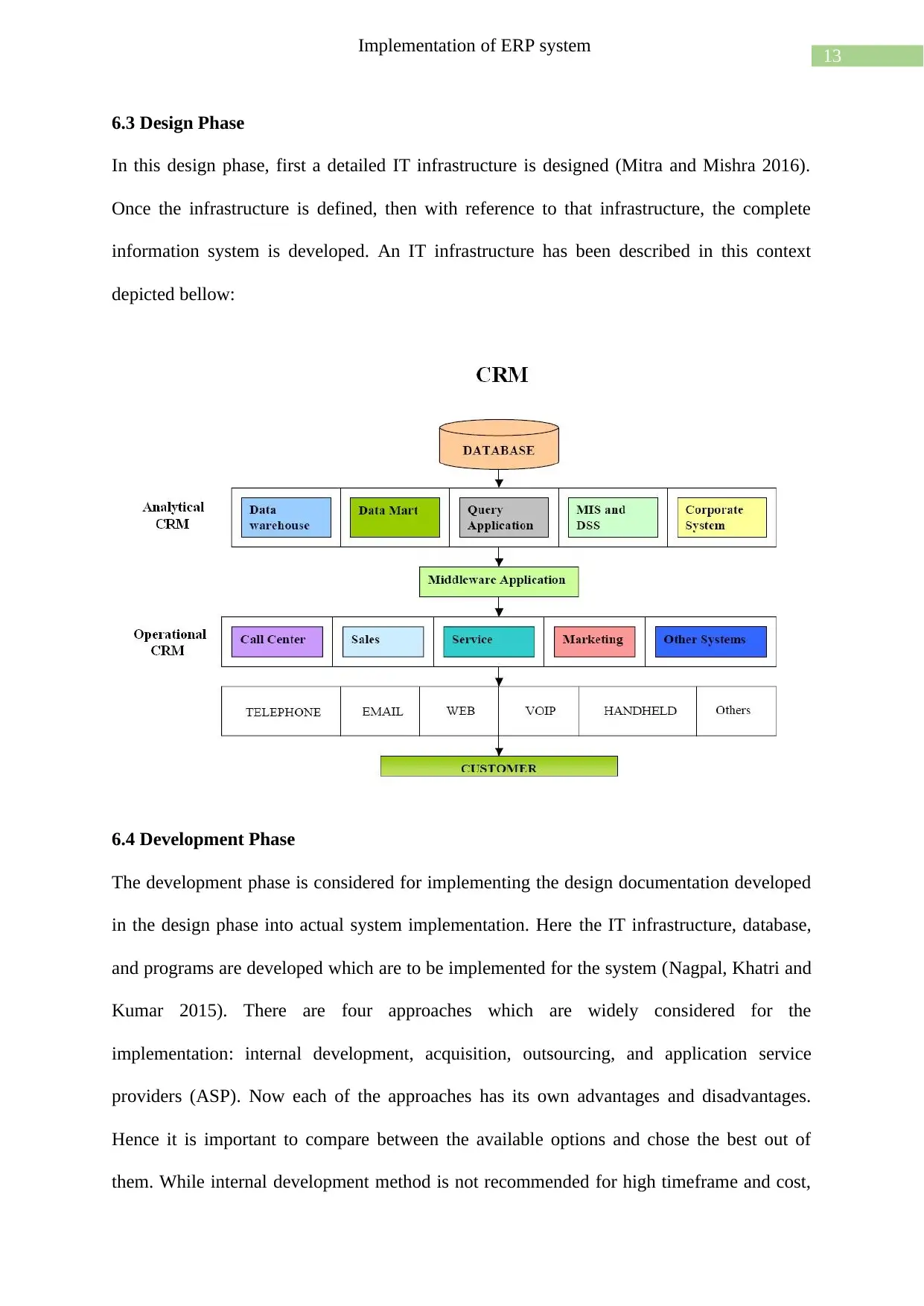
13
Implementation of ERP system
6.3 Design Phase
In this design phase, first a detailed IT infrastructure is designed (Mitra and Mishra 2016).
Once the infrastructure is defined, then with reference to that infrastructure, the complete
information system is developed. An IT infrastructure has been described in this context
depicted bellow:
6.4 Development Phase
The development phase is considered for implementing the design documentation developed
in the design phase into actual system implementation. Here the IT infrastructure, database,
and programs are developed which are to be implemented for the system (Nagpal, Khatri and
Kumar 2015). There are four approaches which are widely considered for the
implementation: internal development, acquisition, outsourcing, and application service
providers (ASP). Now each of the approaches has its own advantages and disadvantages.
Hence it is important to compare between the available options and chose the best out of
them. While internal development method is not recommended for high timeframe and cost,
Implementation of ERP system
6.3 Design Phase
In this design phase, first a detailed IT infrastructure is designed (Mitra and Mishra 2016).
Once the infrastructure is defined, then with reference to that infrastructure, the complete
information system is developed. An IT infrastructure has been described in this context
depicted bellow:
6.4 Development Phase
The development phase is considered for implementing the design documentation developed
in the design phase into actual system implementation. Here the IT infrastructure, database,
and programs are developed which are to be implemented for the system (Nagpal, Khatri and
Kumar 2015). There are four approaches which are widely considered for the
implementation: internal development, acquisition, outsourcing, and application service
providers (ASP). Now each of the approaches has its own advantages and disadvantages.
Hence it is important to compare between the available options and chose the best out of
them. While internal development method is not recommended for high timeframe and cost,
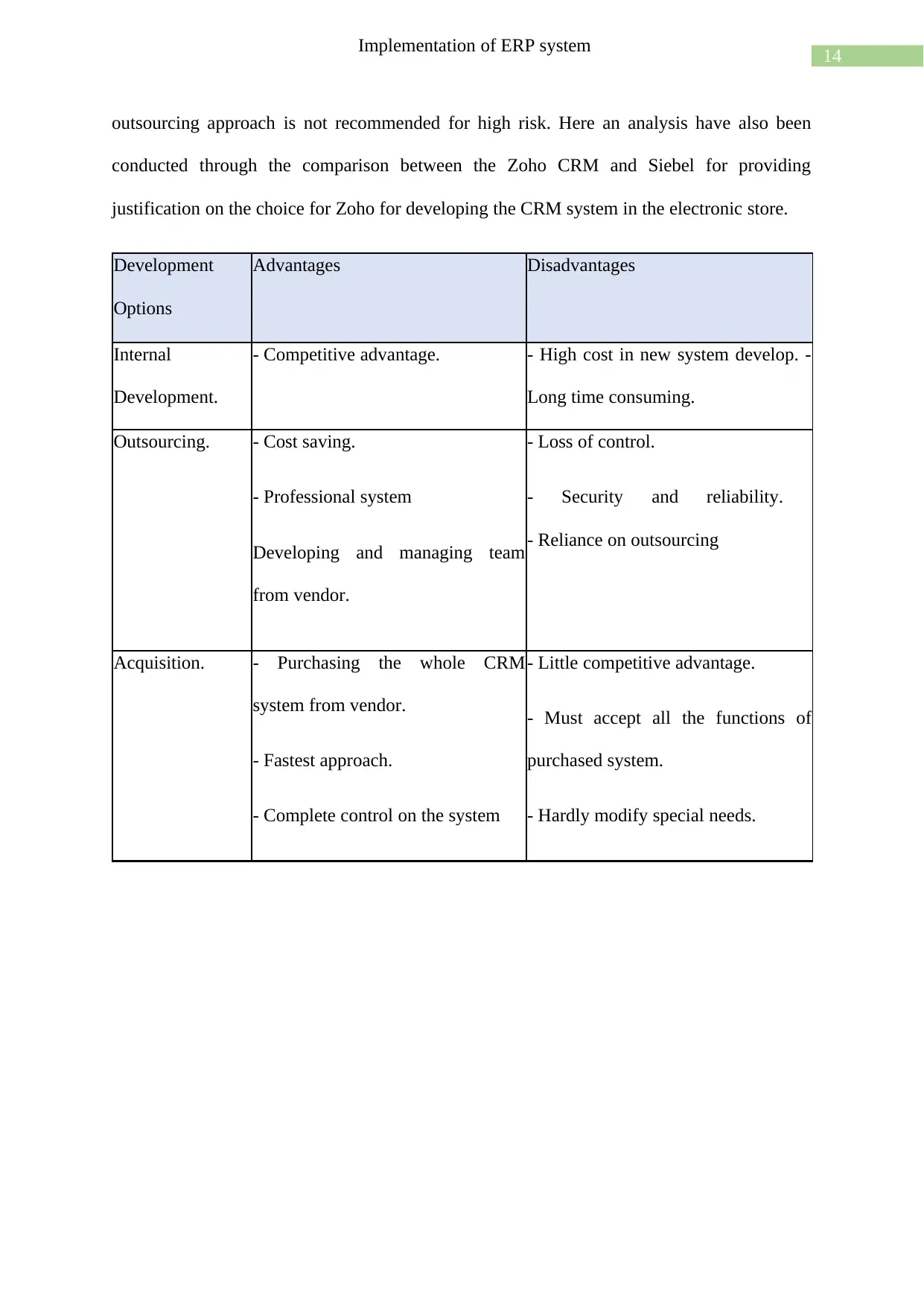
14
Implementation of ERP system
outsourcing approach is not recommended for high risk. Here an analysis have also been
conducted through the comparison between the Zoho CRM and Siebel for providing
justification on the choice for Zoho for developing the CRM system in the electronic store.
Development
Options
Advantages Disadvantages
Internal
Development.
- Competitive advantage. - High cost in new system develop. -
Long time consuming.
Outsourcing. - Cost saving.
- Professional system
Developing and managing team
from vendor.
- Loss of control.
- Security and reliability.
- Reliance on outsourcing
Acquisition. - Purchasing the whole CRM
system from vendor.
- Fastest approach.
- Complete control on the system
- Little competitive advantage.
- Must accept all the functions of
purchased system.
- Hardly modify special needs.
Implementation of ERP system
outsourcing approach is not recommended for high risk. Here an analysis have also been
conducted through the comparison between the Zoho CRM and Siebel for providing
justification on the choice for Zoho for developing the CRM system in the electronic store.
Development
Options
Advantages Disadvantages
Internal
Development.
- Competitive advantage. - High cost in new system develop. -
Long time consuming.
Outsourcing. - Cost saving.
- Professional system
Developing and managing team
from vendor.
- Loss of control.
- Security and reliability.
- Reliance on outsourcing
Acquisition. - Purchasing the whole CRM
system from vendor.
- Fastest approach.
- Complete control on the system
- Little competitive advantage.
- Must accept all the functions of
purchased system.
- Hardly modify special needs.
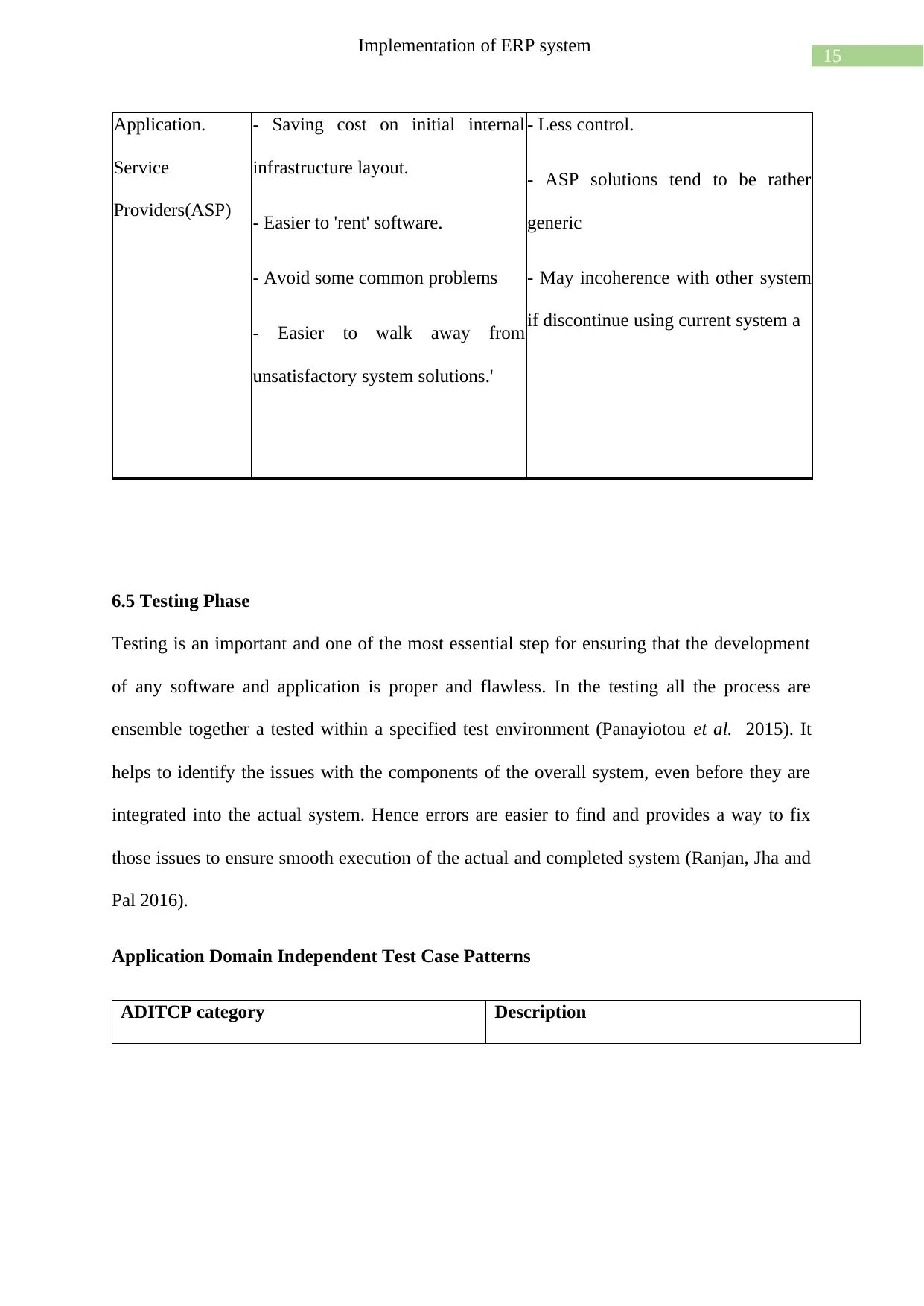
15
Implementation of ERP system
Application.
Service
Providers(ASP)
- Saving cost on initial internal
infrastructure layout.
- Easier to 'rent' software.
- Avoid some common problems
- Easier to walk away from
unsatisfactory system solutions.'
- Less control.
- ASP solutions tend to be rather
generic
- May incoherence with other system
if discontinue using current system a
6.5 Testing Phase
Testing is an important and one of the most essential step for ensuring that the development
of any software and application is proper and flawless. In the testing all the process are
ensemble together a tested within a specified test environment (Panayiotou et al. 2015). It
helps to identify the issues with the components of the overall system, even before they are
integrated into the actual system. Hence errors are easier to find and provides a way to fix
those issues to ensure smooth execution of the actual and completed system (Ranjan, Jha and
Pal 2016).
Application Domain Independent Test Case Patterns
ADITCP category Description
Implementation of ERP system
Application.
Service
Providers(ASP)
- Saving cost on initial internal
infrastructure layout.
- Easier to 'rent' software.
- Avoid some common problems
- Easier to walk away from
unsatisfactory system solutions.'
- Less control.
- ASP solutions tend to be rather
generic
- May incoherence with other system
if discontinue using current system a
6.5 Testing Phase
Testing is an important and one of the most essential step for ensuring that the development
of any software and application is proper and flawless. In the testing all the process are
ensemble together a tested within a specified test environment (Panayiotou et al. 2015). It
helps to identify the issues with the components of the overall system, even before they are
integrated into the actual system. Hence errors are easier to find and provides a way to fix
those issues to ensure smooth execution of the actual and completed system (Ranjan, Jha and
Pal 2016).
Application Domain Independent Test Case Patterns
ADITCP category Description
Secure Best Marks with AI Grader
Need help grading? Try our AI Grader for instant feedback on your assignments.
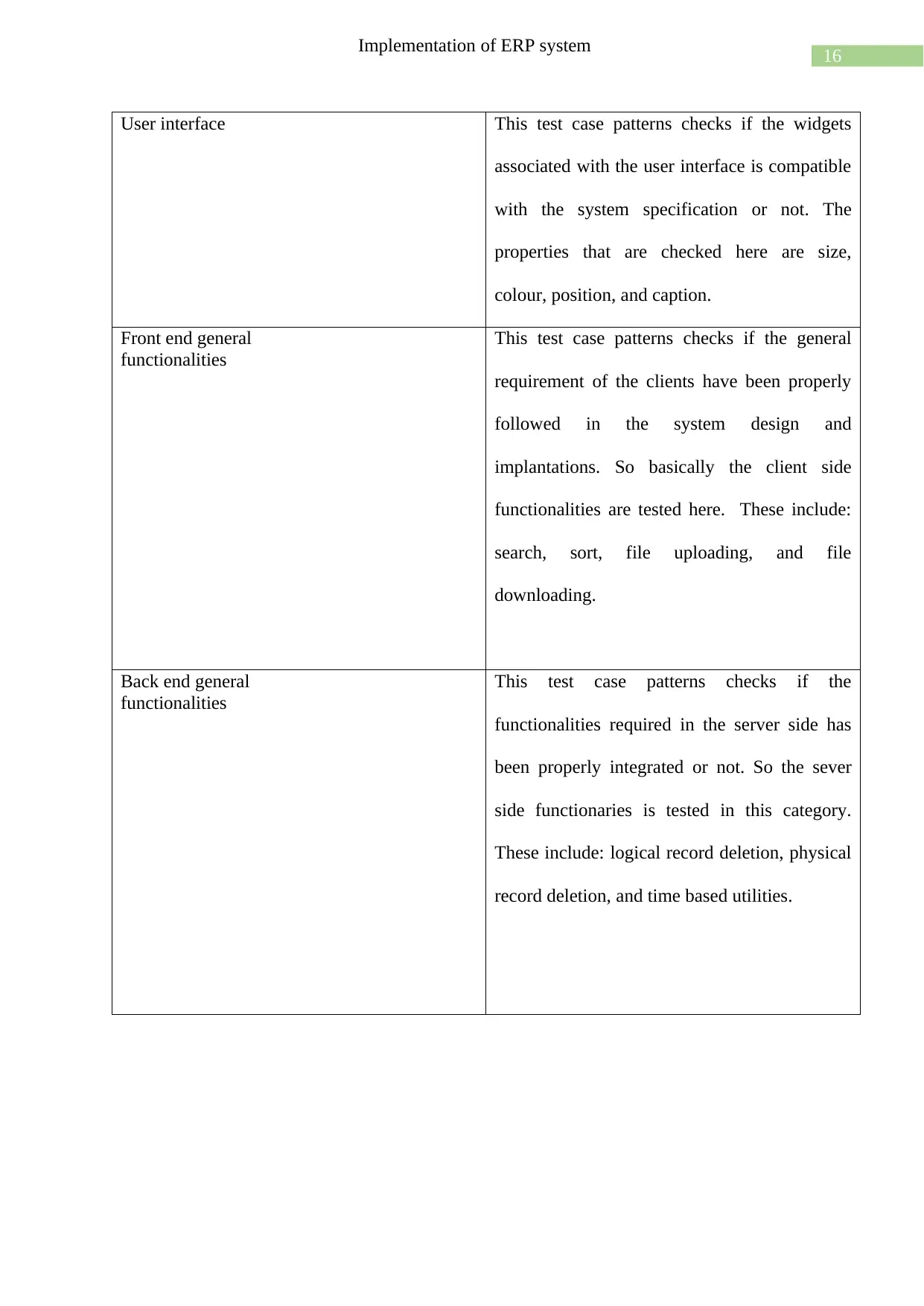
16
Implementation of ERP system
User interface This test case patterns checks if the widgets
associated with the user interface is compatible
with the system specification or not. The
properties that are checked here are size,
colour, position, and caption.
Front end general
functionalities
This test case patterns checks if the general
requirement of the clients have been properly
followed in the system design and
implantations. So basically the client side
functionalities are tested here. These include:
search, sort, file uploading, and file
downloading.
Back end general
functionalities
This test case patterns checks if the
functionalities required in the server side has
been properly integrated or not. So the sever
side functionaries is tested in this category.
These include: logical record deletion, physical
record deletion, and time based utilities.
Implementation of ERP system
User interface This test case patterns checks if the widgets
associated with the user interface is compatible
with the system specification or not. The
properties that are checked here are size,
colour, position, and caption.
Front end general
functionalities
This test case patterns checks if the general
requirement of the clients have been properly
followed in the system design and
implantations. So basically the client side
functionalities are tested here. These include:
search, sort, file uploading, and file
downloading.
Back end general
functionalities
This test case patterns checks if the
functionalities required in the server side has
been properly integrated or not. So the sever
side functionaries is tested in this category.
These include: logical record deletion, physical
record deletion, and time based utilities.
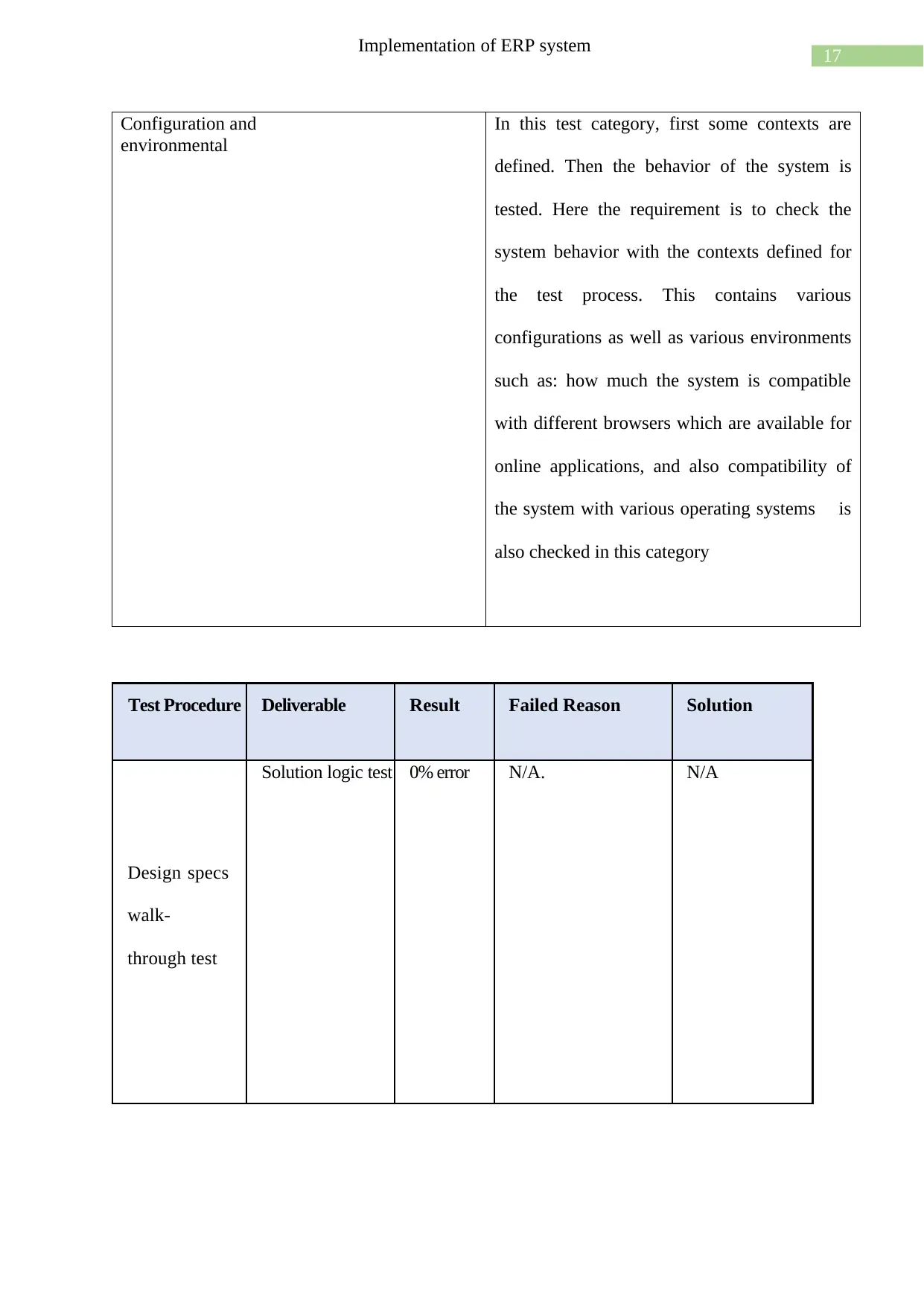
17
Implementation of ERP system
Configuration and
environmental
In this test category, first some contexts are
defined. Then the behavior of the system is
tested. Here the requirement is to check the
system behavior with the contexts defined for
the test process. This contains various
configurations as well as various environments
such as: how much the system is compatible
with different browsers which are available for
online applications, and also compatibility of
the system with various operating systems is
also checked in this category
Test Procedure Deliverable Result Failed Reason Solution
Design specs
walk-
through test
Solution logic test 0% error N/A. N/A
Implementation of ERP system
Configuration and
environmental
In this test category, first some contexts are
defined. Then the behavior of the system is
tested. Here the requirement is to check the
system behavior with the contexts defined for
the test process. This contains various
configurations as well as various environments
such as: how much the system is compatible
with different browsers which are available for
online applications, and also compatibility of
the system with various operating systems is
also checked in this category
Test Procedure Deliverable Result Failed Reason Solution
Design specs
walk-
through test
Solution logic test 0% error N/A. N/A
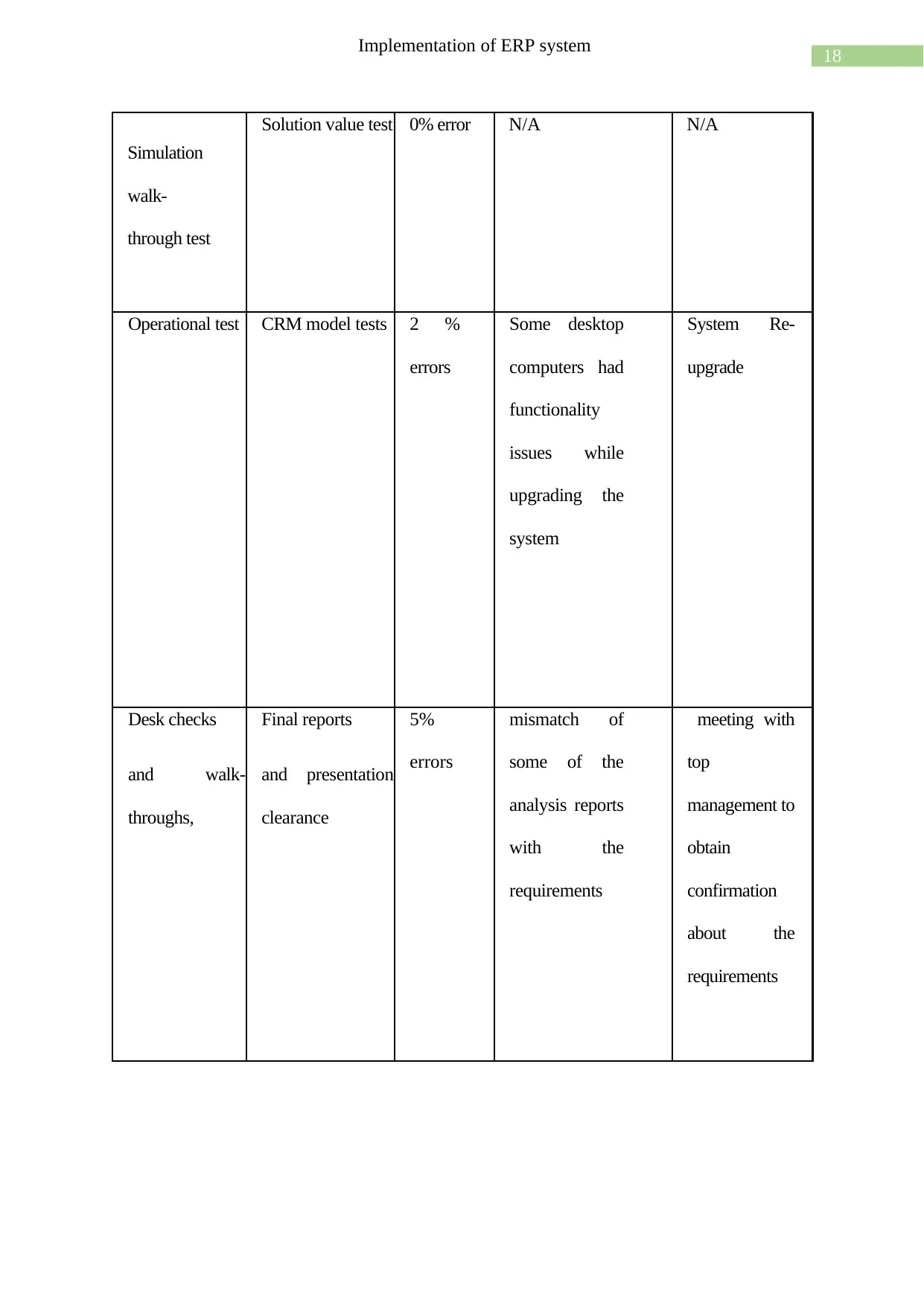
18
Implementation of ERP system
Simulation
walk-
through test
Solution value test 0% error N/A N/A
Operational test CRM model tests 2 %
errors
Some desktop
computers had
functionality
issues while
upgrading the
system
System Re-
upgrade
Desk checks
and walk-
throughs,
Final reports
and presentation
clearance
5%
errors
mismatch of
some of the
analysis reports
with the
requirements
meeting with
top
management to
obtain
confirmation
about the
requirements
Implementation of ERP system
Simulation
walk-
through test
Solution value test 0% error N/A N/A
Operational test CRM model tests 2 %
errors
Some desktop
computers had
functionality
issues while
upgrading the
system
System Re-
upgrade
Desk checks
and walk-
throughs,
Final reports
and presentation
clearance
5%
errors
mismatch of
some of the
analysis reports
with the
requirements
meeting with
top
management to
obtain
confirmation
about the
requirements
Paraphrase This Document
Need a fresh take? Get an instant paraphrase of this document with our AI Paraphraser
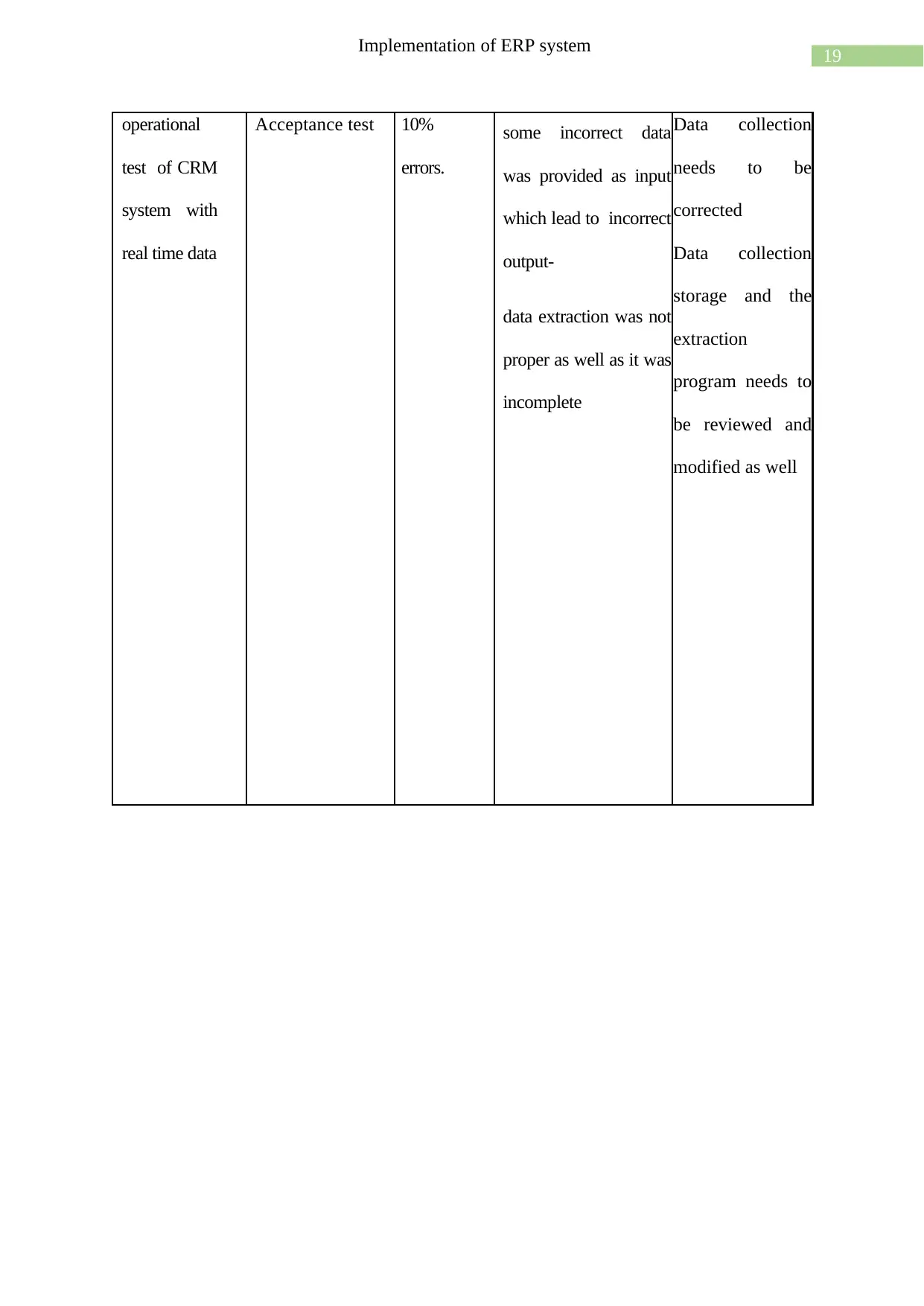
19
Implementation of ERP system
operational
test of CRM
system with
real time data
Acceptance test 10%
errors.
some incorrect data
was provided as input
which lead to incorrect
output-
data extraction was not
proper as well as it was
incomplete
Data collection
needs to be
corrected
Data collection
storage and the
extraction
program needs to
be reviewed and
modified as well
Implementation of ERP system
operational
test of CRM
system with
real time data
Acceptance test 10%
errors.
some incorrect data
was provided as input
which lead to incorrect
output-
data extraction was not
proper as well as it was
incomplete
Data collection
needs to be
corrected
Data collection
storage and the
extraction
program needs to
be reviewed and
modified as well
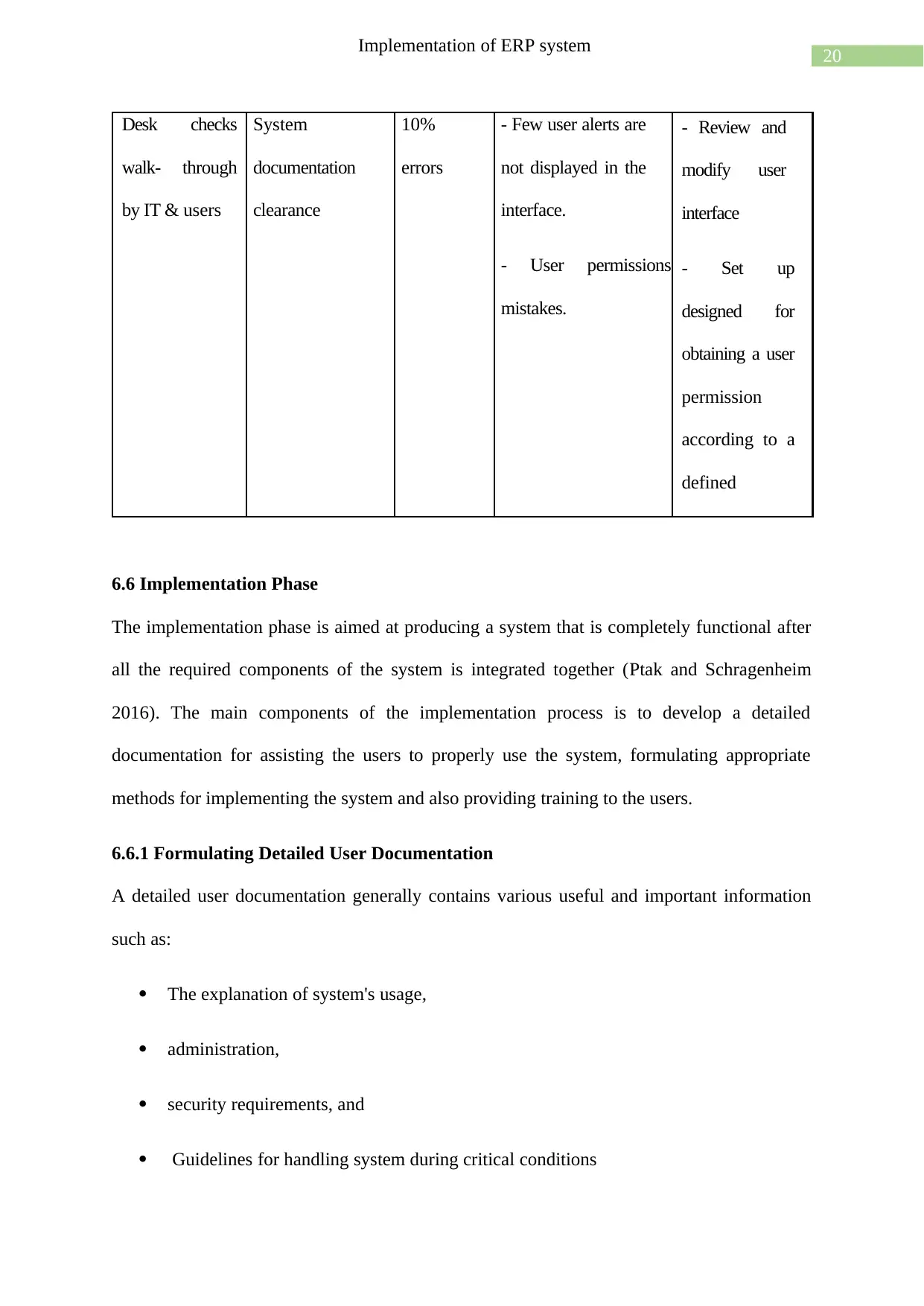
20
Implementation of ERP system
Desk checks
walk- through
by IT & users
System
documentation
clearance
10%
errors
- Few user alerts are
not displayed in the
interface.
- User permissions
mistakes.
- Review and
modify user
interface
- Set up
designed for
obtaining a user
permission
according to a
defined
hierarchical
6.6 Implementation Phase
The implementation phase is aimed at producing a system that is completely functional after
all the required components of the system is integrated together (Ptak and Schragenheim
2016). The main components of the implementation process is to develop a detailed
documentation for assisting the users to properly use the system, formulating appropriate
methods for implementing the system and also providing training to the users.
6.6.1 Formulating Detailed User Documentation
A detailed user documentation generally contains various useful and important information
such as:
The explanation of system's usage,
administration,
security requirements, and
Guidelines for handling system during critical conditions
Implementation of ERP system
Desk checks
walk- through
by IT & users
System
documentation
clearance
10%
errors
- Few user alerts are
not displayed in the
interface.
- User permissions
mistakes.
- Review and
modify user
interface
- Set up
designed for
obtaining a user
permission
according to a
defined
hierarchical
6.6 Implementation Phase
The implementation phase is aimed at producing a system that is completely functional after
all the required components of the system is integrated together (Ptak and Schragenheim
2016). The main components of the implementation process is to develop a detailed
documentation for assisting the users to properly use the system, formulating appropriate
methods for implementing the system and also providing training to the users.
6.6.1 Formulating Detailed User Documentation
A detailed user documentation generally contains various useful and important information
such as:
The explanation of system's usage,
administration,
security requirements, and
Guidelines for handling system during critical conditions
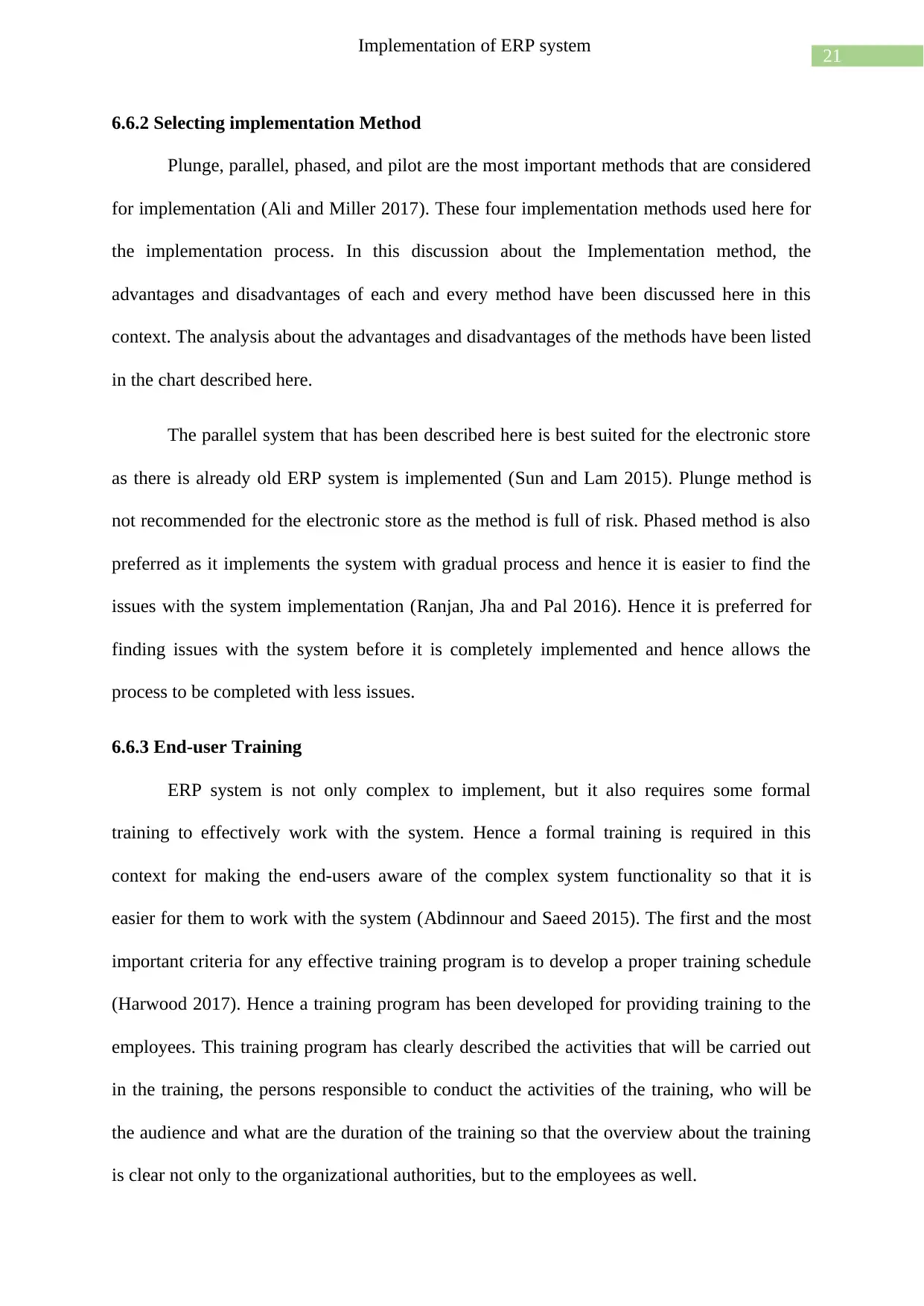
21
Implementation of ERP system
6.6.2 Selecting implementation Method
Plunge, parallel, phased, and pilot are the most important methods that are considered
for implementation (Ali and Miller 2017). These four implementation methods used here for
the implementation process. In this discussion about the Implementation method, the
advantages and disadvantages of each and every method have been discussed here in this
context. The analysis about the advantages and disadvantages of the methods have been listed
in the chart described here.
The parallel system that has been described here is best suited for the electronic store
as there is already old ERP system is implemented (Sun and Lam 2015). Plunge method is
not recommended for the electronic store as the method is full of risk. Phased method is also
preferred as it implements the system with gradual process and hence it is easier to find the
issues with the system implementation (Ranjan, Jha and Pal 2016). Hence it is preferred for
finding issues with the system before it is completely implemented and hence allows the
process to be completed with less issues.
6.6.3 End-user Training
ERP system is not only complex to implement, but it also requires some formal
training to effectively work with the system. Hence a formal training is required in this
context for making the end-users aware of the complex system functionality so that it is
easier for them to work with the system (Abdinnour and Saeed 2015). The first and the most
important criteria for any effective training program is to develop a proper training schedule
(Harwood 2017). Hence a training program has been developed for providing training to the
employees. This training program has clearly described the activities that will be carried out
in the training, the persons responsible to conduct the activities of the training, who will be
the audience and what are the duration of the training so that the overview about the training
is clear not only to the organizational authorities, but to the employees as well.
Implementation of ERP system
6.6.2 Selecting implementation Method
Plunge, parallel, phased, and pilot are the most important methods that are considered
for implementation (Ali and Miller 2017). These four implementation methods used here for
the implementation process. In this discussion about the Implementation method, the
advantages and disadvantages of each and every method have been discussed here in this
context. The analysis about the advantages and disadvantages of the methods have been listed
in the chart described here.
The parallel system that has been described here is best suited for the electronic store
as there is already old ERP system is implemented (Sun and Lam 2015). Plunge method is
not recommended for the electronic store as the method is full of risk. Phased method is also
preferred as it implements the system with gradual process and hence it is easier to find the
issues with the system implementation (Ranjan, Jha and Pal 2016). Hence it is preferred for
finding issues with the system before it is completely implemented and hence allows the
process to be completed with less issues.
6.6.3 End-user Training
ERP system is not only complex to implement, but it also requires some formal
training to effectively work with the system. Hence a formal training is required in this
context for making the end-users aware of the complex system functionality so that it is
easier for them to work with the system (Abdinnour and Saeed 2015). The first and the most
important criteria for any effective training program is to develop a proper training schedule
(Harwood 2017). Hence a training program has been developed for providing training to the
employees. This training program has clearly described the activities that will be carried out
in the training, the persons responsible to conduct the activities of the training, who will be
the audience and what are the duration of the training so that the overview about the training
is clear not only to the organizational authorities, but to the employees as well.
Secure Best Marks with AI Grader
Need help grading? Try our AI Grader for instant feedback on your assignments.
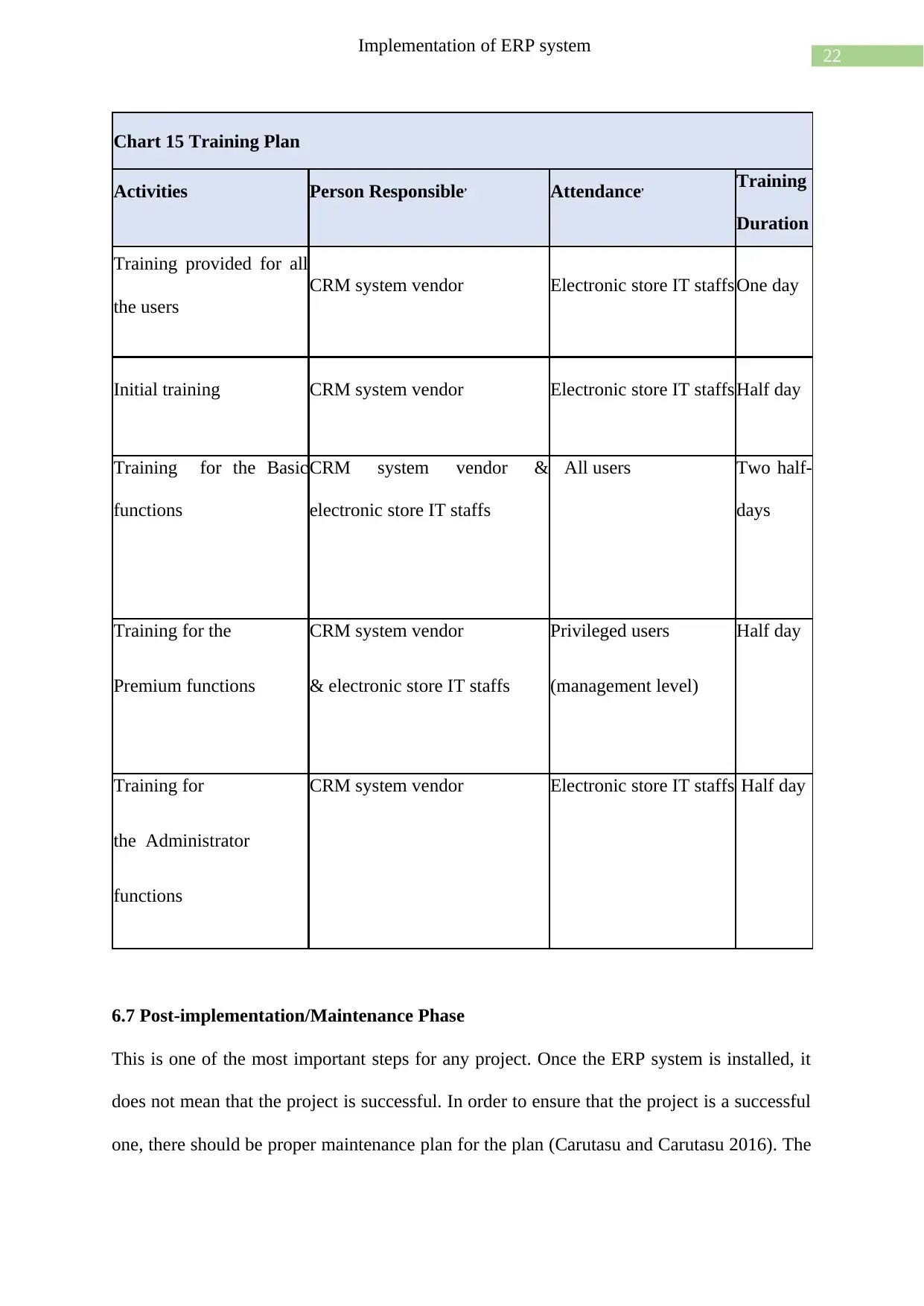
22
Implementation of ERP system
Chart 15 Training Plan
Activities Person Responsible, Attendance, Training
Duration
Training provided for all
the users
CRM system vendor Electronic store IT staffsOne day
Initial training CRM system vendor Electronic store IT staffsHalf day
Training for the Basic
functions
CRM system vendor &
electronic store IT staffs
All users Two half-
days
Training for the
Premium functions
CRM system vendor
& electronic store IT staffs
Privileged users
(management level)
Half day
Training for
the Administrator
functions
CRM system vendor Electronic store IT staffs Half day
6.7 Post-implementation/Maintenance Phase
This is one of the most important steps for any project. Once the ERP system is installed, it
does not mean that the project is successful. In order to ensure that the project is a successful
one, there should be proper maintenance plan for the plan (Carutasu and Carutasu 2016). The
Implementation of ERP system
Chart 15 Training Plan
Activities Person Responsible, Attendance, Training
Duration
Training provided for all
the users
CRM system vendor Electronic store IT staffsOne day
Initial training CRM system vendor Electronic store IT staffsHalf day
Training for the Basic
functions
CRM system vendor &
electronic store IT staffs
All users Two half-
days
Training for the
Premium functions
CRM system vendor
& electronic store IT staffs
Privileged users
(management level)
Half day
Training for
the Administrator
functions
CRM system vendor Electronic store IT staffs Half day
6.7 Post-implementation/Maintenance Phase
This is one of the most important steps for any project. Once the ERP system is installed, it
does not mean that the project is successful. In order to ensure that the project is a successful
one, there should be proper maintenance plan for the plan (Carutasu and Carutasu 2016). The
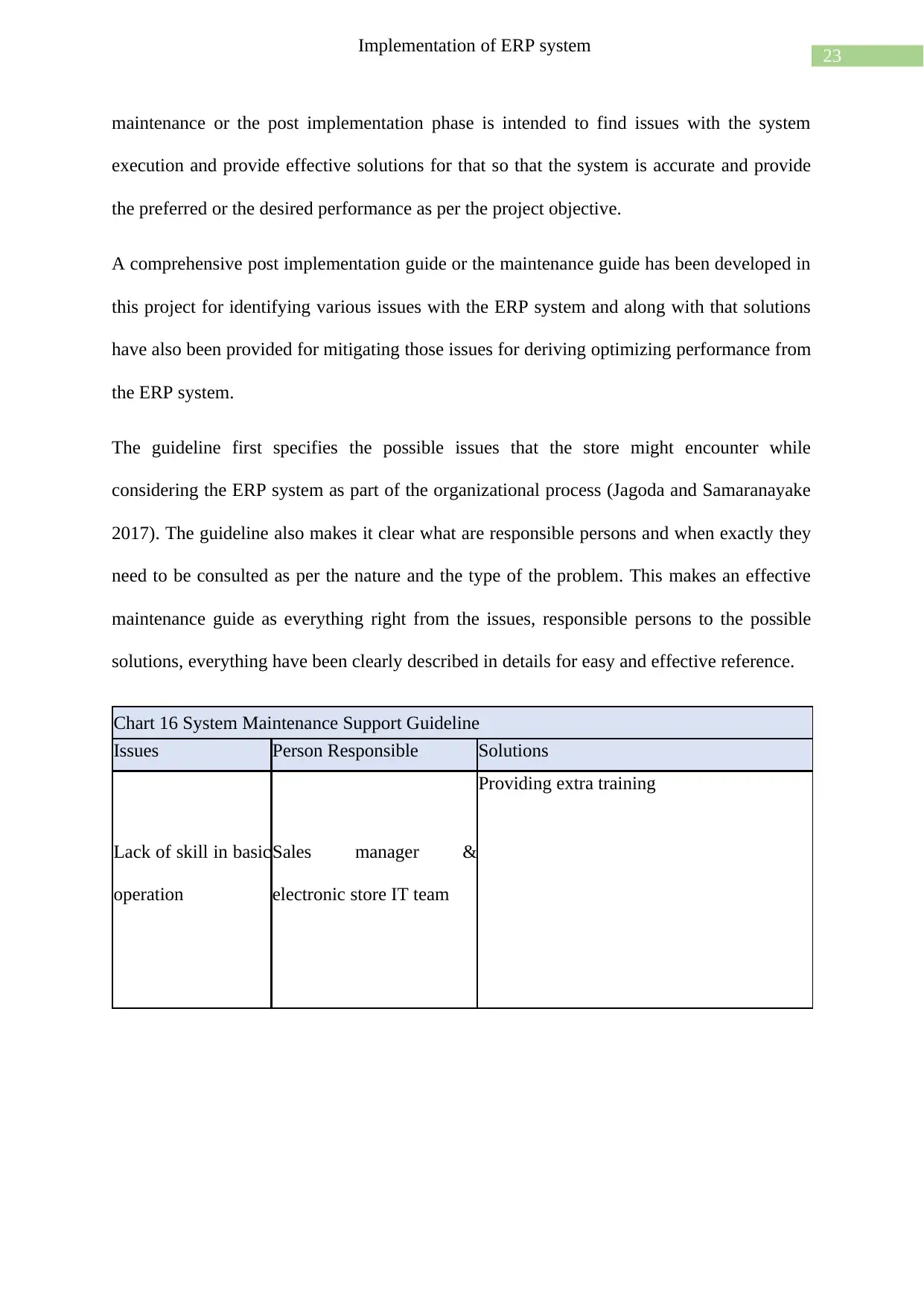
23
Implementation of ERP system
maintenance or the post implementation phase is intended to find issues with the system
execution and provide effective solutions for that so that the system is accurate and provide
the preferred or the desired performance as per the project objective.
A comprehensive post implementation guide or the maintenance guide has been developed in
this project for identifying various issues with the ERP system and along with that solutions
have also been provided for mitigating those issues for deriving optimizing performance from
the ERP system.
The guideline first specifies the possible issues that the store might encounter while
considering the ERP system as part of the organizational process (Jagoda and Samaranayake
2017). The guideline also makes it clear what are responsible persons and when exactly they
need to be consulted as per the nature and the type of the problem. This makes an effective
maintenance guide as everything right from the issues, responsible persons to the possible
solutions, everything have been clearly described in details for easy and effective reference.
Chart 16 System Maintenance Support Guideline
Issues Person Responsible Solutions
Lack of skill in basic
operation
Sales manager &
electronic store IT team
Providing extra training
Implementation of ERP system
maintenance or the post implementation phase is intended to find issues with the system
execution and provide effective solutions for that so that the system is accurate and provide
the preferred or the desired performance as per the project objective.
A comprehensive post implementation guide or the maintenance guide has been developed in
this project for identifying various issues with the ERP system and along with that solutions
have also been provided for mitigating those issues for deriving optimizing performance from
the ERP system.
The guideline first specifies the possible issues that the store might encounter while
considering the ERP system as part of the organizational process (Jagoda and Samaranayake
2017). The guideline also makes it clear what are responsible persons and when exactly they
need to be consulted as per the nature and the type of the problem. This makes an effective
maintenance guide as everything right from the issues, responsible persons to the possible
solutions, everything have been clearly described in details for easy and effective reference.
Chart 16 System Maintenance Support Guideline
Issues Person Responsible Solutions
Lack of skill in basic
operation
Sales manager &
electronic store IT team
Providing extra training

24
Implementation of ERP system
Improper data
analysis along
with mining function
Sales department head &
electronic store IT team &
system vendor
Reconfirm input correctly
Meeting with electronic store IT team
Meeting with electronic store IT team and
vendor (if out of electronic store control)
Administration issue
Electronic store IT team &
system vendor
Electronic store IT team should
communicate with vendor to find solutions
System upgrade
Electronic store IT team &
system vendor
Electronic store IT team should
communicate with vendor to find solutions
Cyber-security
and resilience
Electronic store IT team &
system vendor &
electronic
store executive committee
- Electronic store project team needs
to report to executive committee in regular
basis"
upgrade system in constant basis
risk management to mitigate cyber security
issues
7. Project Management, Change Management, and Risk Management
7.1 Project Management
Project management is "the application of knowledge, skills, tools, and techniques to project
activities in order to meet project requirements". It includes management of scope, time, cost,
Implementation of ERP system
Improper data
analysis along
with mining function
Sales department head &
electronic store IT team &
system vendor
Reconfirm input correctly
Meeting with electronic store IT team
Meeting with electronic store IT team and
vendor (if out of electronic store control)
Administration issue
Electronic store IT team &
system vendor
Electronic store IT team should
communicate with vendor to find solutions
System upgrade
Electronic store IT team &
system vendor
Electronic store IT team should
communicate with vendor to find solutions
Cyber-security
and resilience
Electronic store IT team &
system vendor &
electronic
store executive committee
- Electronic store project team needs
to report to executive committee in regular
basis"
upgrade system in constant basis
risk management to mitigate cyber security
issues
7. Project Management, Change Management, and Risk Management
7.1 Project Management
Project management is "the application of knowledge, skills, tools, and techniques to project
activities in order to meet project requirements". It includes management of scope, time, cost,
Paraphrase This Document
Need a fresh take? Get an instant paraphrase of this document with our AI Paraphraser
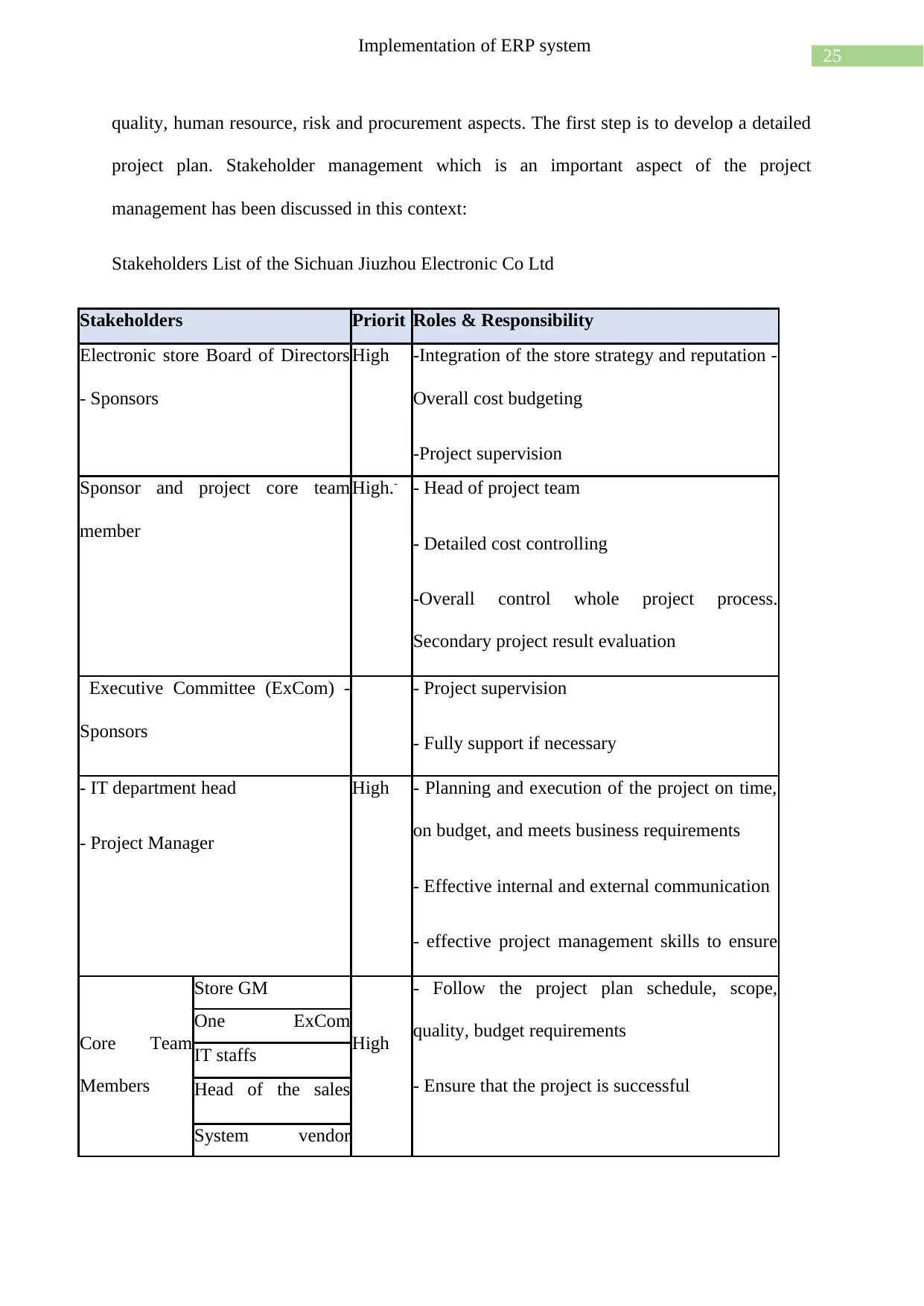
25
Implementation of ERP system
quality, human resource, risk and procurement aspects. The first step is to develop a detailed
project plan. Stakeholder management which is an important aspect of the project
management has been discussed in this context:
Stakeholders List of the Sichuan Jiuzhou Electronic Co Ltd
Stakeholders Priorit
y
Roles & Responsibility
Electronic store Board of Directors
- Sponsors
High -Integration of the store strategy and reputation -
Overall cost budgeting
-Project supervision
Sponsor and project core team
member
High.- - Head of project team
- Detailed cost controlling
-Overall control whole project process.
Secondary project result evaluation
Executive Committee (ExCom) -
Sponsors
- Project supervision
- Fully support if necessary
- IT department head
- Project Manager
High - Planning and execution of the project on time,
on budget, and meets business requirements
- Effective internal and external communication
- effective project management skills to ensure
that the project goal is achieved
Core Team
Members
Store GM
High
- Follow the project plan schedule, scope,
quality, budget requirements
- Ensure that the project is successful
One ExCom
memberIT staffs
Head of the sales
departmentSystem vendor
(external)
Implementation of ERP system
quality, human resource, risk and procurement aspects. The first step is to develop a detailed
project plan. Stakeholder management which is an important aspect of the project
management has been discussed in this context:
Stakeholders List of the Sichuan Jiuzhou Electronic Co Ltd
Stakeholders Priorit
y
Roles & Responsibility
Electronic store Board of Directors
- Sponsors
High -Integration of the store strategy and reputation -
Overall cost budgeting
-Project supervision
Sponsor and project core team
member
High.- - Head of project team
- Detailed cost controlling
-Overall control whole project process.
Secondary project result evaluation
Executive Committee (ExCom) -
Sponsors
- Project supervision
- Fully support if necessary
- IT department head
- Project Manager
High - Planning and execution of the project on time,
on budget, and meets business requirements
- Effective internal and external communication
- effective project management skills to ensure
that the project goal is achieved
Core Team
Members
Store GM
High
- Follow the project plan schedule, scope,
quality, budget requirements
- Ensure that the project is successful
One ExCom
memberIT staffs
Head of the sales
departmentSystem vendor
(external)
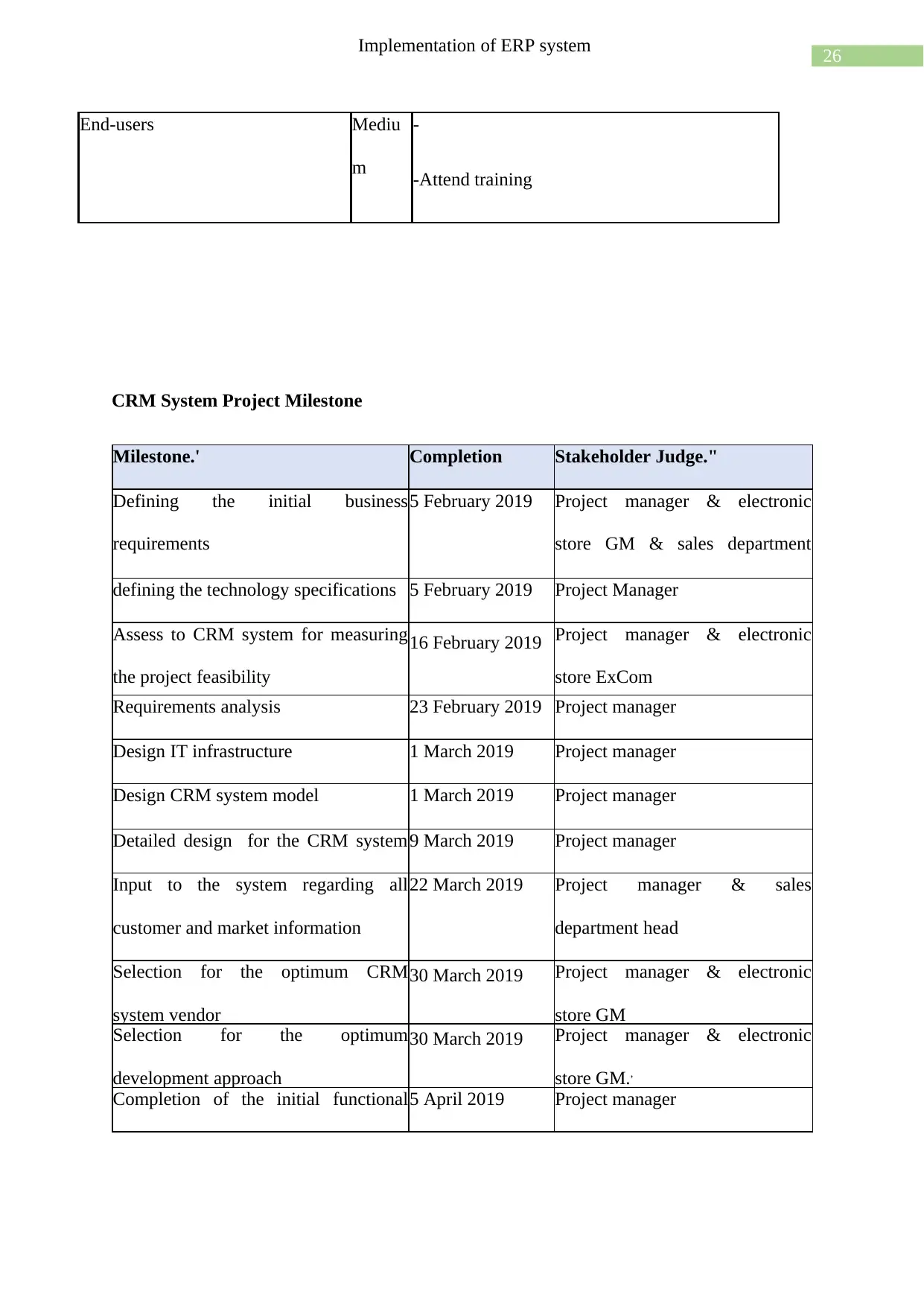
26
Implementation of ERP system
End-users Mediu
m
-
-Attend training
CRM System Project Milestone
Milestone.' Completion
Date."
Stakeholder Judge."
Defining the initial business
requirements
5 February 2019 Project manager & electronic
store GM & sales department
headdefining the technology specifications 5 February 2019 Project Manager
Assess to CRM system for measuring
the project feasibility
16 February 2019 Project manager & electronic
store ExCom
Requirements analysis 23 February 2019 Project manager
Design IT infrastructure 1 March 2019 Project manager
Design CRM system model 1 March 2019 Project manager
Detailed design for the CRM system
and its associated documents
9 March 2019 Project manager
Input to the system regarding all
customer and market information
22 March 2019 Project manager & sales
department head
Selection for the optimum CRM
system vendor
30 March 2019 Project manager & electronic
store GM
Selection for the optimum
development approach
30 March 2019 Project manager & electronic
store GM.,
Completion of the initial functional
testing
5 April 2019 Project manager
Implementation of ERP system
End-users Mediu
m
-
-Attend training
CRM System Project Milestone
Milestone.' Completion
Date."
Stakeholder Judge."
Defining the initial business
requirements
5 February 2019 Project manager & electronic
store GM & sales department
headdefining the technology specifications 5 February 2019 Project Manager
Assess to CRM system for measuring
the project feasibility
16 February 2019 Project manager & electronic
store ExCom
Requirements analysis 23 February 2019 Project manager
Design IT infrastructure 1 March 2019 Project manager
Design CRM system model 1 March 2019 Project manager
Detailed design for the CRM system
and its associated documents
9 March 2019 Project manager
Input to the system regarding all
customer and market information
22 March 2019 Project manager & sales
department head
Selection for the optimum CRM
system vendor
30 March 2019 Project manager & electronic
store GM
Selection for the optimum
development approach
30 March 2019 Project manager & electronic
store GM.,
Completion of the initial functional
testing
5 April 2019 Project manager
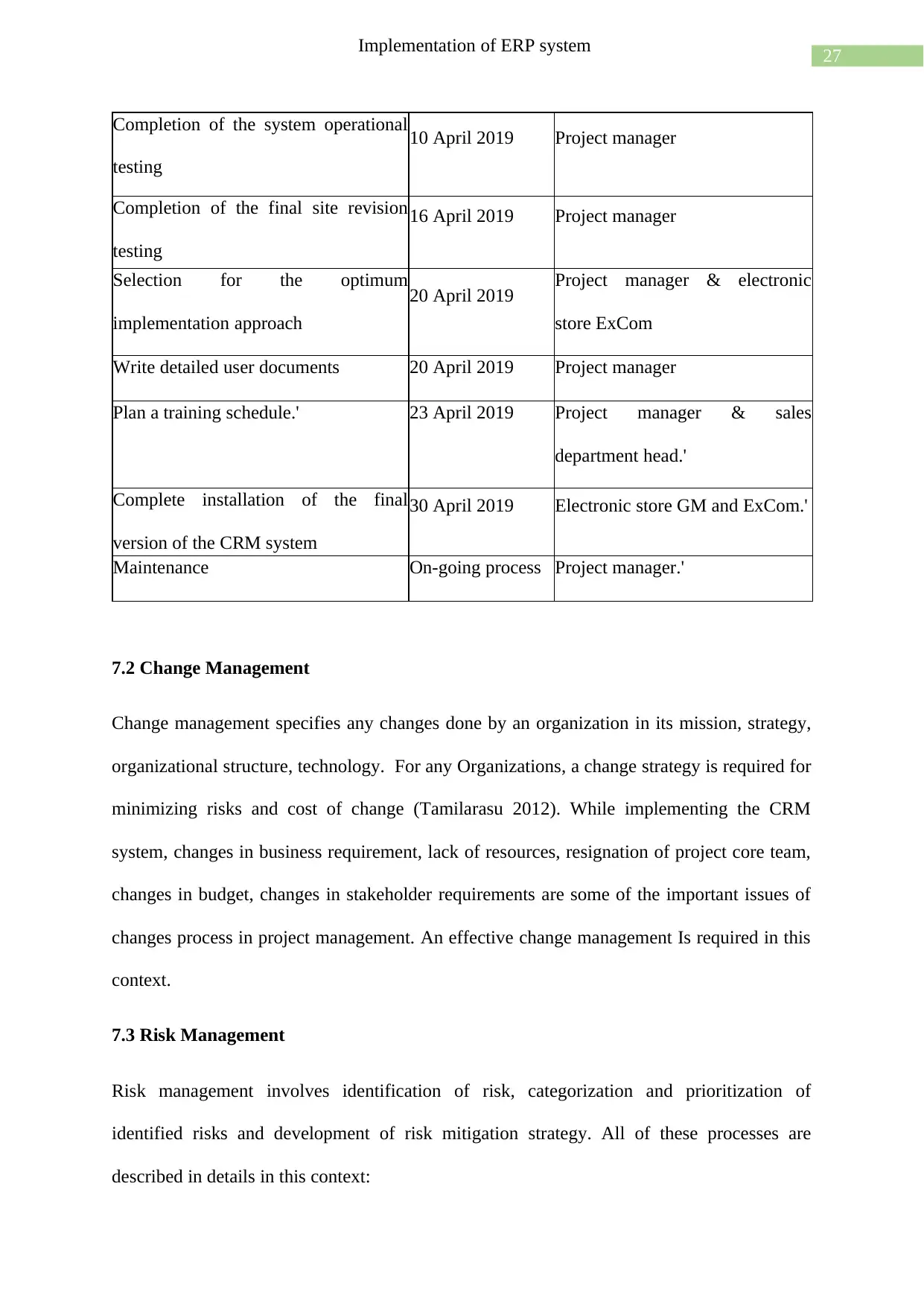
27
Implementation of ERP system
Completion of the system operational
testing
10 April 2019 Project manager
Completion of the final site revision
testing
16 April 2019 Project manager
Selection for the optimum
implementation approach
20 April 2019 Project manager & electronic
store ExCom
Write detailed user documents 20 April 2019 Project manager
Plan a training schedule.' 23 April 2019 Project manager & sales
department head.'
Complete installation of the final
version of the CRM system
30 April 2019 Electronic store GM and ExCom.'
Maintenance On-going process Project manager.'
7.2 Change Management
Change management specifies any changes done by an organization in its mission, strategy,
organizational structure, technology. For any Organizations, a change strategy is required for
minimizing risks and cost of change (Tamilarasu 2012). While implementing the CRM
system, changes in business requirement, lack of resources, resignation of project core team,
changes in budget, changes in stakeholder requirements are some of the important issues of
changes process in project management. An effective change management Is required in this
context.
7.3 Risk Management
Risk management involves identification of risk, categorization and prioritization of
identified risks and development of risk mitigation strategy. All of these processes are
described in details in this context:
Implementation of ERP system
Completion of the system operational
testing
10 April 2019 Project manager
Completion of the final site revision
testing
16 April 2019 Project manager
Selection for the optimum
implementation approach
20 April 2019 Project manager & electronic
store ExCom
Write detailed user documents 20 April 2019 Project manager
Plan a training schedule.' 23 April 2019 Project manager & sales
department head.'
Complete installation of the final
version of the CRM system
30 April 2019 Electronic store GM and ExCom.'
Maintenance On-going process Project manager.'
7.2 Change Management
Change management specifies any changes done by an organization in its mission, strategy,
organizational structure, technology. For any Organizations, a change strategy is required for
minimizing risks and cost of change (Tamilarasu 2012). While implementing the CRM
system, changes in business requirement, lack of resources, resignation of project core team,
changes in budget, changes in stakeholder requirements are some of the important issues of
changes process in project management. An effective change management Is required in this
context.
7.3 Risk Management
Risk management involves identification of risk, categorization and prioritization of
identified risks and development of risk mitigation strategy. All of these processes are
described in details in this context:
Secure Best Marks with AI Grader
Need help grading? Try our AI Grader for instant feedback on your assignments.
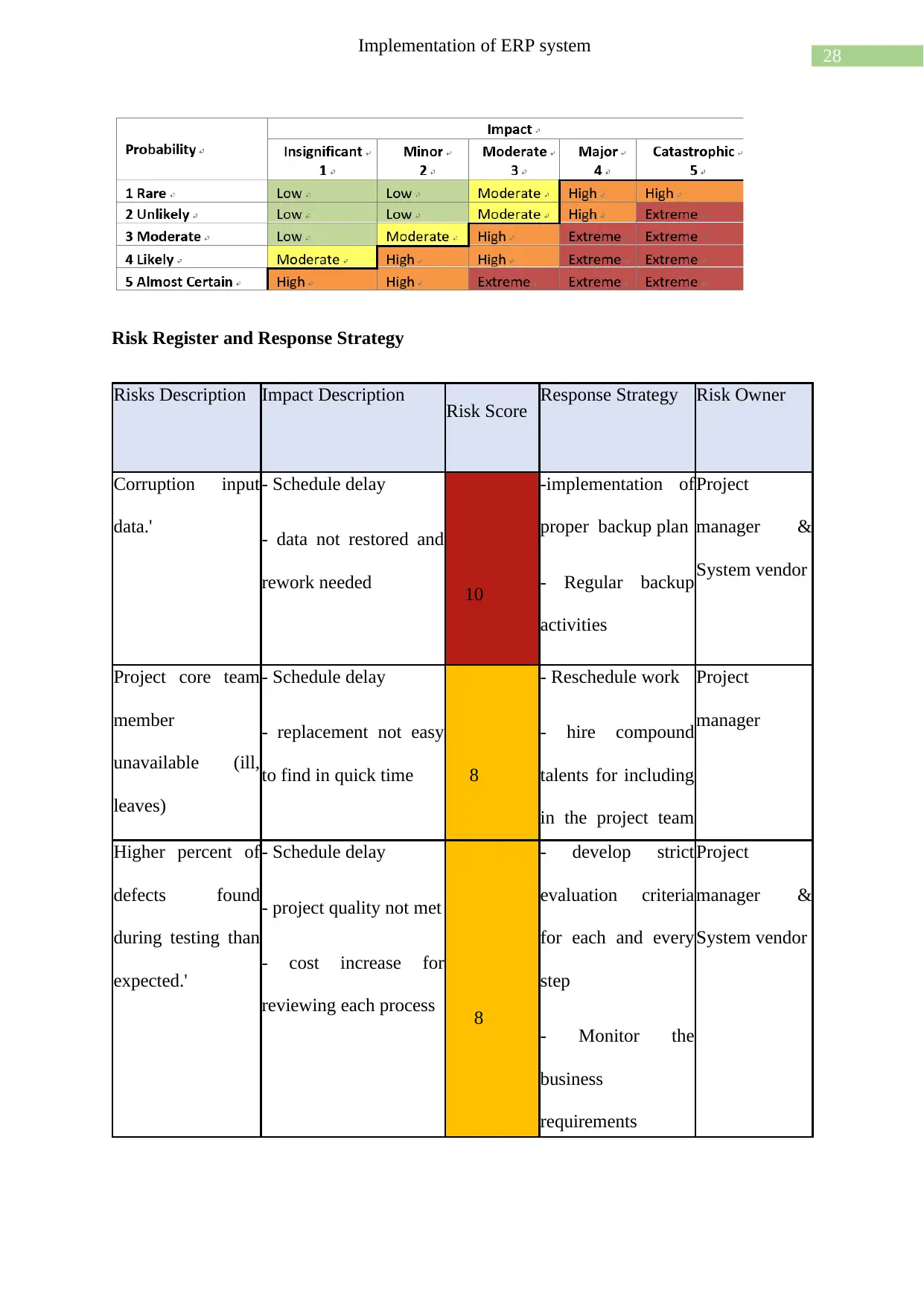
28
Implementation of ERP system
Risk Register and Response Strategy
Risks Description Impact Description Risk Score Response Strategy Risk Owner
Corruption input
data.'
- Schedule delay
- data not restored and
rework needed 10
-implementation of
proper backup plan
- Regular backup
activities
Project
manager &
System vendor
Project core team
member
unavailable (ill,
leaves)
- Schedule delay
- replacement not easy
to find in quick time 8
- Reschedule work
- hire compound
talents for including
in the project team
members
Project
manager
Higher percent of
defects found
during testing than
expected.'
- Schedule delay
- project quality not met
- cost increase for
reviewing each process 8
- develop strict
evaluation criteria
for each and every
step
- Monitor the
business
requirements
properly
Project
manager &
System vendor
Implementation of ERP system
Risk Register and Response Strategy
Risks Description Impact Description Risk Score Response Strategy Risk Owner
Corruption input
data.'
- Schedule delay
- data not restored and
rework needed 10
-implementation of
proper backup plan
- Regular backup
activities
Project
manager &
System vendor
Project core team
member
unavailable (ill,
leaves)
- Schedule delay
- replacement not easy
to find in quick time 8
- Reschedule work
- hire compound
talents for including
in the project team
members
Project
manager
Higher percent of
defects found
during testing than
expected.'
- Schedule delay
- project quality not met
- cost increase for
reviewing each process 8
- develop strict
evaluation criteria
for each and every
step
- Monitor the
business
requirements
properly
Project
manager &
System vendor
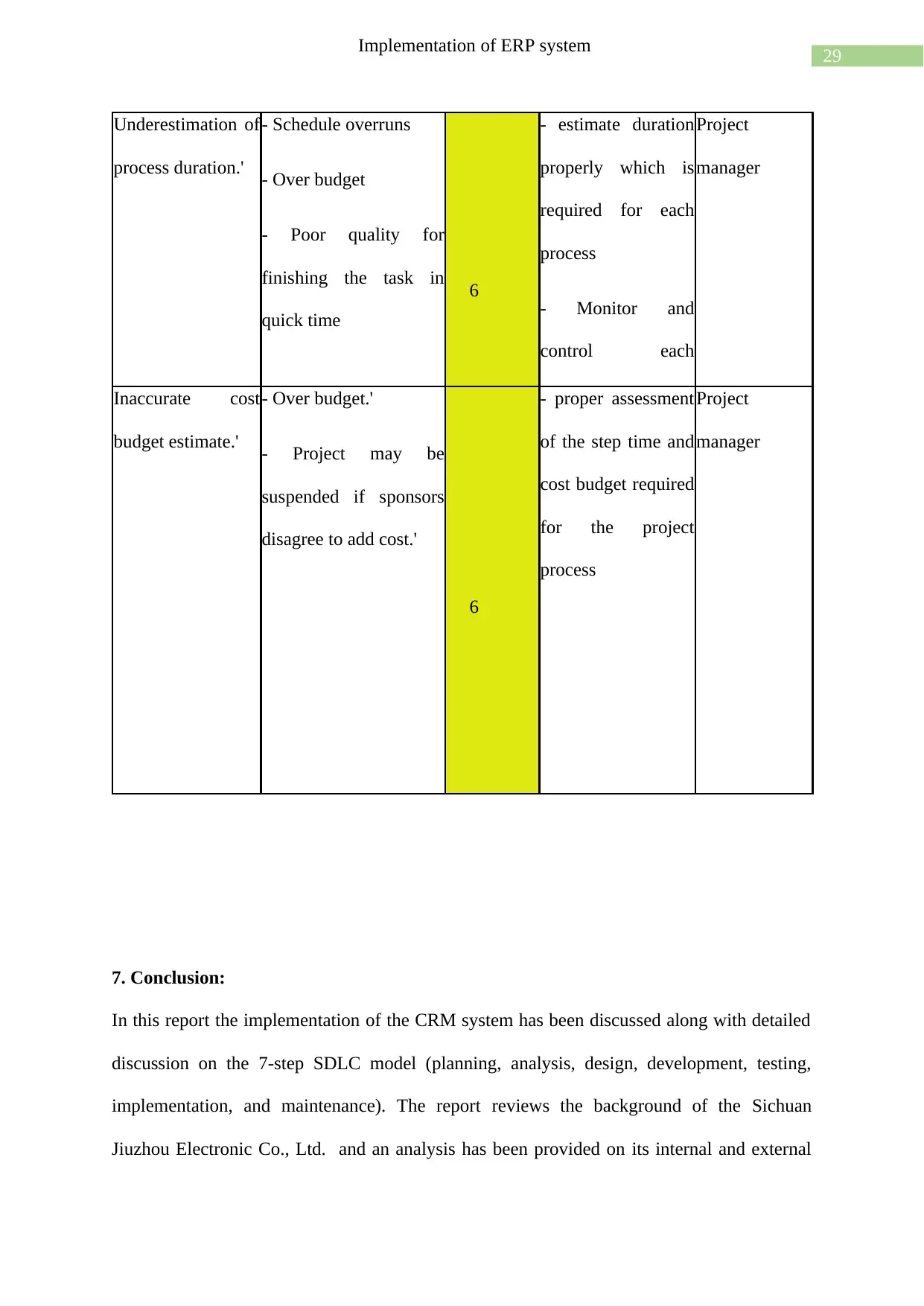
29
Implementation of ERP system
Underestimation of
process duration.'
- Schedule overruns
- Over budget
- Poor quality for
finishing the task in
quick time
6
- estimate duration
properly which is
required for each
process
- Monitor and
control each
schedule
Project
manager
Inaccurate cost
budget estimate.'
- Over budget.'
- Project may be
suspended if sponsors
disagree to add cost.'
6
- proper assessment
of the step time and
cost budget required
for the project
process
Project
manager
7. Conclusion:
In this report the implementation of the CRM system has been discussed along with detailed
discussion on the 7-step SDLC model (planning, analysis, design, development, testing,
implementation, and maintenance). The report reviews the background of the Sichuan
Jiuzhou Electronic Co., Ltd. and an analysis has been provided on its internal and external
Implementation of ERP system
Underestimation of
process duration.'
- Schedule overruns
- Over budget
- Poor quality for
finishing the task in
quick time
6
- estimate duration
properly which is
required for each
process
- Monitor and
control each
schedule
Project
manager
Inaccurate cost
budget estimate.'
- Over budget.'
- Project may be
suspended if sponsors
disagree to add cost.'
6
- proper assessment
of the step time and
cost budget required
for the project
process
Project
manager
7. Conclusion:
In this report the implementation of the CRM system has been discussed along with detailed
discussion on the 7-step SDLC model (planning, analysis, design, development, testing,
implementation, and maintenance). The report reviews the background of the Sichuan
Jiuzhou Electronic Co., Ltd. and an analysis has been provided on its internal and external
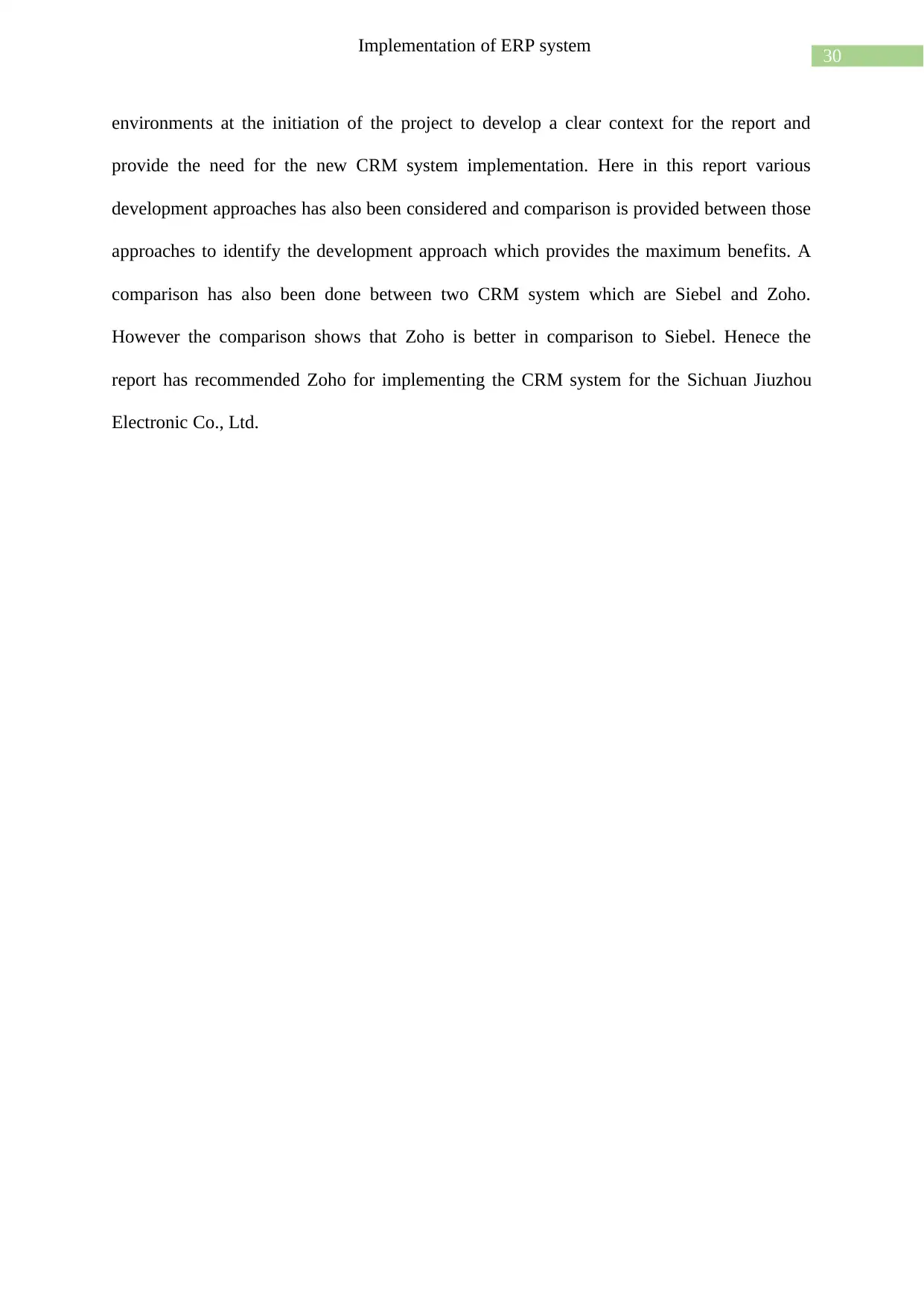
30
Implementation of ERP system
environments at the initiation of the project to develop a clear context for the report and
provide the need for the new CRM system implementation. Here in this report various
development approaches has also been considered and comparison is provided between those
approaches to identify the development approach which provides the maximum benefits. A
comparison has also been done between two CRM system which are Siebel and Zoho.
However the comparison shows that Zoho is better in comparison to Siebel. Henece the
report has recommended Zoho for implementing the CRM system for the Sichuan Jiuzhou
Electronic Co., Ltd.
Implementation of ERP system
environments at the initiation of the project to develop a clear context for the report and
provide the need for the new CRM system implementation. Here in this report various
development approaches has also been considered and comparison is provided between those
approaches to identify the development approach which provides the maximum benefits. A
comparison has also been done between two CRM system which are Siebel and Zoho.
However the comparison shows that Zoho is better in comparison to Siebel. Henece the
report has recommended Zoho for implementing the CRM system for the Sichuan Jiuzhou
Electronic Co., Ltd.
Paraphrase This Document
Need a fresh take? Get an instant paraphrase of this document with our AI Paraphraser
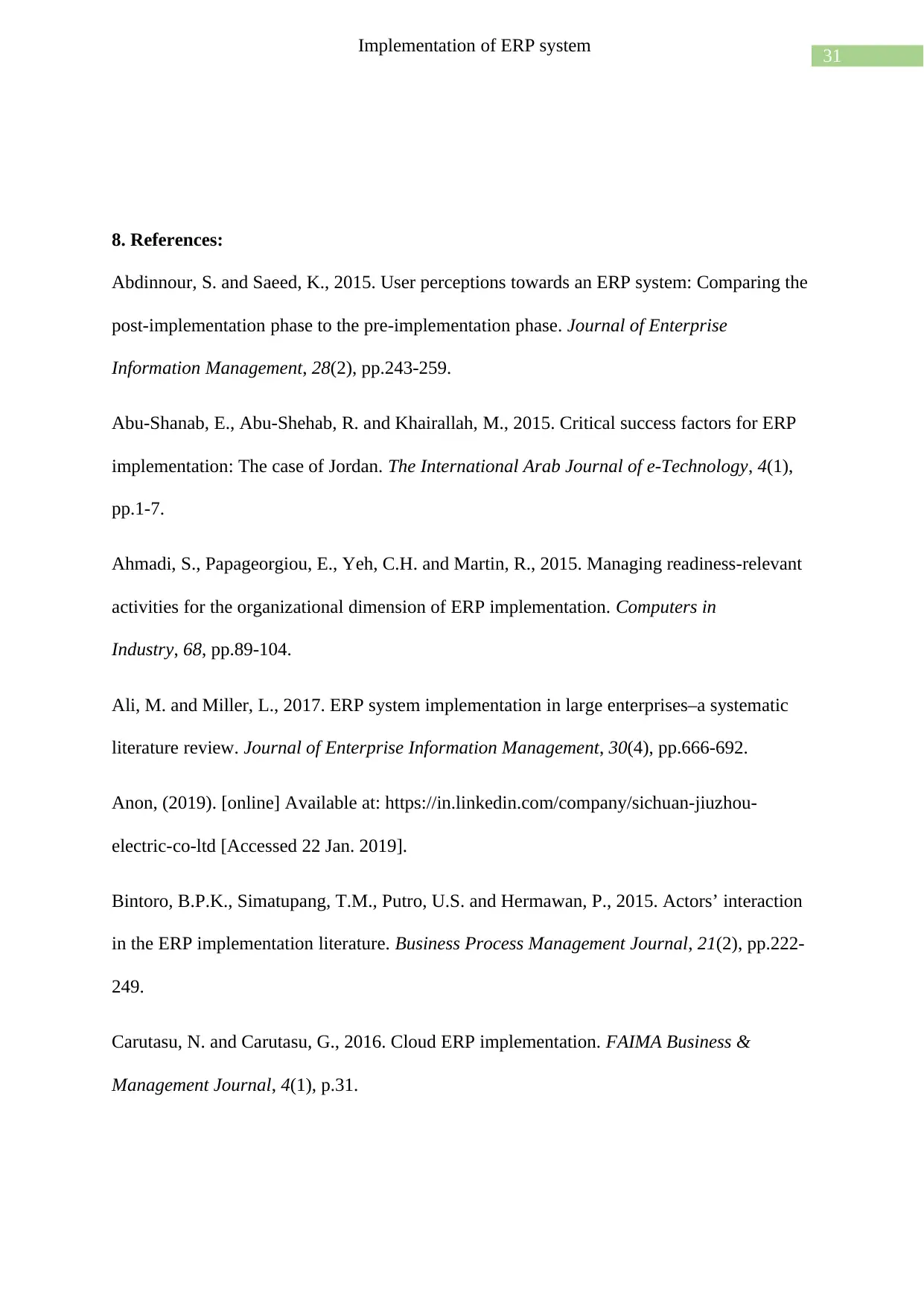
31
Implementation of ERP system
8. References:
Abdinnour, S. and Saeed, K., 2015. User perceptions towards an ERP system: Comparing the
post-implementation phase to the pre-implementation phase. Journal of Enterprise
Information Management, 28(2), pp.243-259.
Abu-Shanab, E., Abu-Shehab, R. and Khairallah, M., 2015. Critical success factors for ERP
implementation: The case of Jordan. The International Arab Journal of e-Technology, 4(1),
pp.1-7.
Ahmadi, S., Papageorgiou, E., Yeh, C.H. and Martin, R., 2015. Managing readiness-relevant
activities for the organizational dimension of ERP implementation. Computers in
Industry, 68, pp.89-104.
Ali, M. and Miller, L., 2017. ERP system implementation in large enterprises–a systematic
literature review. Journal of Enterprise Information Management, 30(4), pp.666-692.
Anon, (2019). [online] Available at: https://in.linkedin.com/company/sichuan-jiuzhou-
electric-co-ltd [Accessed 22 Jan. 2019].
Bintoro, B.P.K., Simatupang, T.M., Putro, U.S. and Hermawan, P., 2015. Actors’ interaction
in the ERP implementation literature. Business Process Management Journal, 21(2), pp.222-
249.
Carutasu, N. and Carutasu, G., 2016. Cloud ERP implementation. FAIMA Business &
Management Journal, 4(1), p.31.
Implementation of ERP system
8. References:
Abdinnour, S. and Saeed, K., 2015. User perceptions towards an ERP system: Comparing the
post-implementation phase to the pre-implementation phase. Journal of Enterprise
Information Management, 28(2), pp.243-259.
Abu-Shanab, E., Abu-Shehab, R. and Khairallah, M., 2015. Critical success factors for ERP
implementation: The case of Jordan. The International Arab Journal of e-Technology, 4(1),
pp.1-7.
Ahmadi, S., Papageorgiou, E., Yeh, C.H. and Martin, R., 2015. Managing readiness-relevant
activities for the organizational dimension of ERP implementation. Computers in
Industry, 68, pp.89-104.
Ali, M. and Miller, L., 2017. ERP system implementation in large enterprises–a systematic
literature review. Journal of Enterprise Information Management, 30(4), pp.666-692.
Anon, (2019). [online] Available at: https://in.linkedin.com/company/sichuan-jiuzhou-
electric-co-ltd [Accessed 22 Jan. 2019].
Bintoro, B.P.K., Simatupang, T.M., Putro, U.S. and Hermawan, P., 2015. Actors’ interaction
in the ERP implementation literature. Business Process Management Journal, 21(2), pp.222-
249.
Carutasu, N. and Carutasu, G., 2016. Cloud ERP implementation. FAIMA Business &
Management Journal, 4(1), p.31.
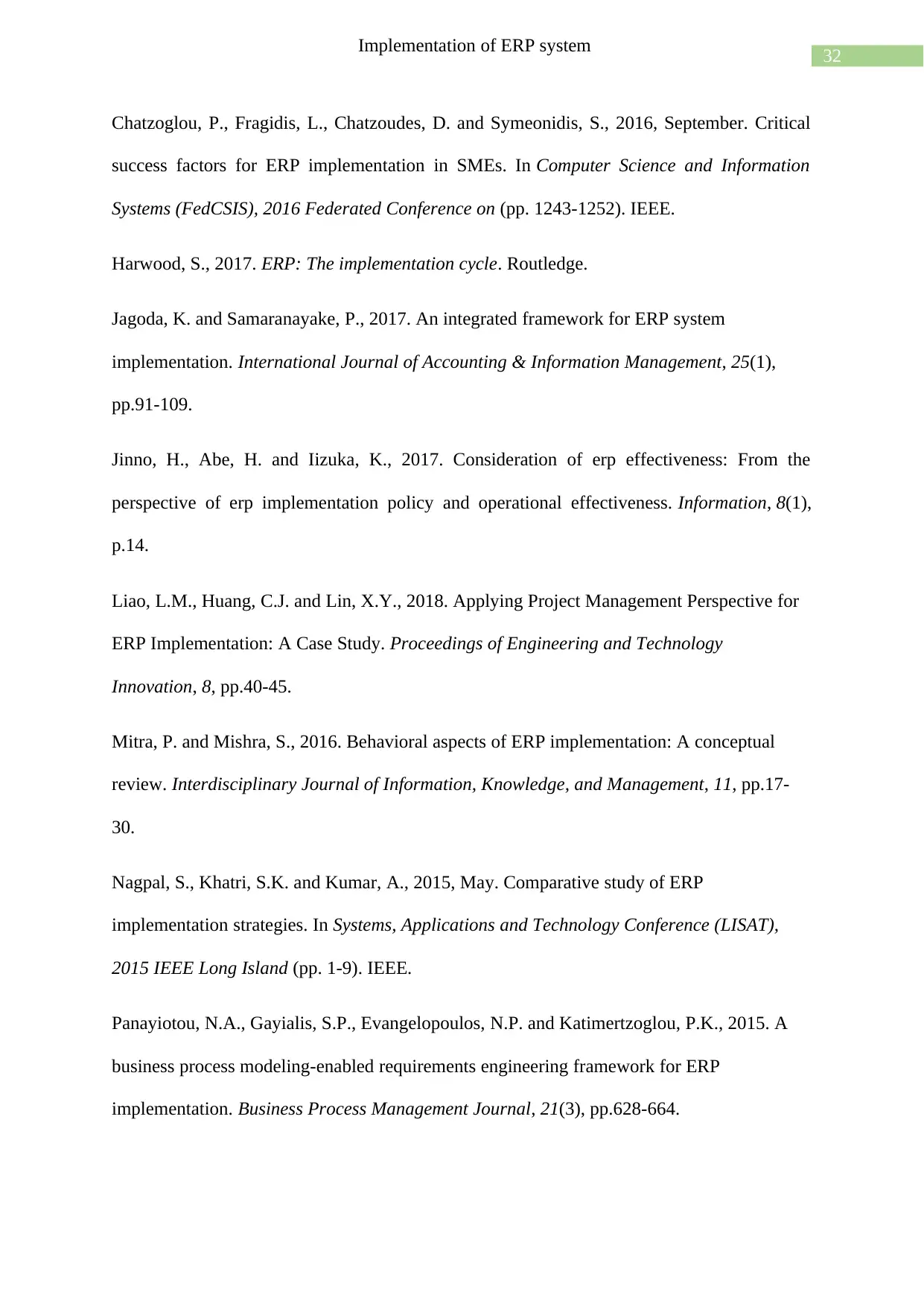
32
Implementation of ERP system
Chatzoglou, P., Fragidis, L., Chatzoudes, D. and Symeonidis, S., 2016, September. Critical
success factors for ERP implementation in SMEs. In Computer Science and Information
Systems (FedCSIS), 2016 Federated Conference on (pp. 1243-1252). IEEE.
Harwood, S., 2017. ERP: The implementation cycle. Routledge.
Jagoda, K. and Samaranayake, P., 2017. An integrated framework for ERP system
implementation. International Journal of Accounting & Information Management, 25(1),
pp.91-109.
Jinno, H., Abe, H. and Iizuka, K., 2017. Consideration of erp effectiveness: From the
perspective of erp implementation policy and operational effectiveness. Information, 8(1),
p.14.
Liao, L.M., Huang, C.J. and Lin, X.Y., 2018. Applying Project Management Perspective for
ERP Implementation: A Case Study. Proceedings of Engineering and Technology
Innovation, 8, pp.40-45.
Mitra, P. and Mishra, S., 2016. Behavioral aspects of ERP implementation: A conceptual
review. Interdisciplinary Journal of Information, Knowledge, and Management, 11, pp.17-
30.
Nagpal, S., Khatri, S.K. and Kumar, A., 2015, May. Comparative study of ERP
implementation strategies. In Systems, Applications and Technology Conference (LISAT),
2015 IEEE Long Island (pp. 1-9). IEEE.
Panayiotou, N.A., Gayialis, S.P., Evangelopoulos, N.P. and Katimertzoglou, P.K., 2015. A
business process modeling-enabled requirements engineering framework for ERP
implementation. Business Process Management Journal, 21(3), pp.628-664.
Implementation of ERP system
Chatzoglou, P., Fragidis, L., Chatzoudes, D. and Symeonidis, S., 2016, September. Critical
success factors for ERP implementation in SMEs. In Computer Science and Information
Systems (FedCSIS), 2016 Federated Conference on (pp. 1243-1252). IEEE.
Harwood, S., 2017. ERP: The implementation cycle. Routledge.
Jagoda, K. and Samaranayake, P., 2017. An integrated framework for ERP system
implementation. International Journal of Accounting & Information Management, 25(1),
pp.91-109.
Jinno, H., Abe, H. and Iizuka, K., 2017. Consideration of erp effectiveness: From the
perspective of erp implementation policy and operational effectiveness. Information, 8(1),
p.14.
Liao, L.M., Huang, C.J. and Lin, X.Y., 2018. Applying Project Management Perspective for
ERP Implementation: A Case Study. Proceedings of Engineering and Technology
Innovation, 8, pp.40-45.
Mitra, P. and Mishra, S., 2016. Behavioral aspects of ERP implementation: A conceptual
review. Interdisciplinary Journal of Information, Knowledge, and Management, 11, pp.17-
30.
Nagpal, S., Khatri, S.K. and Kumar, A., 2015, May. Comparative study of ERP
implementation strategies. In Systems, Applications and Technology Conference (LISAT),
2015 IEEE Long Island (pp. 1-9). IEEE.
Panayiotou, N.A., Gayialis, S.P., Evangelopoulos, N.P. and Katimertzoglou, P.K., 2015. A
business process modeling-enabled requirements engineering framework for ERP
implementation. Business Process Management Journal, 21(3), pp.628-664.
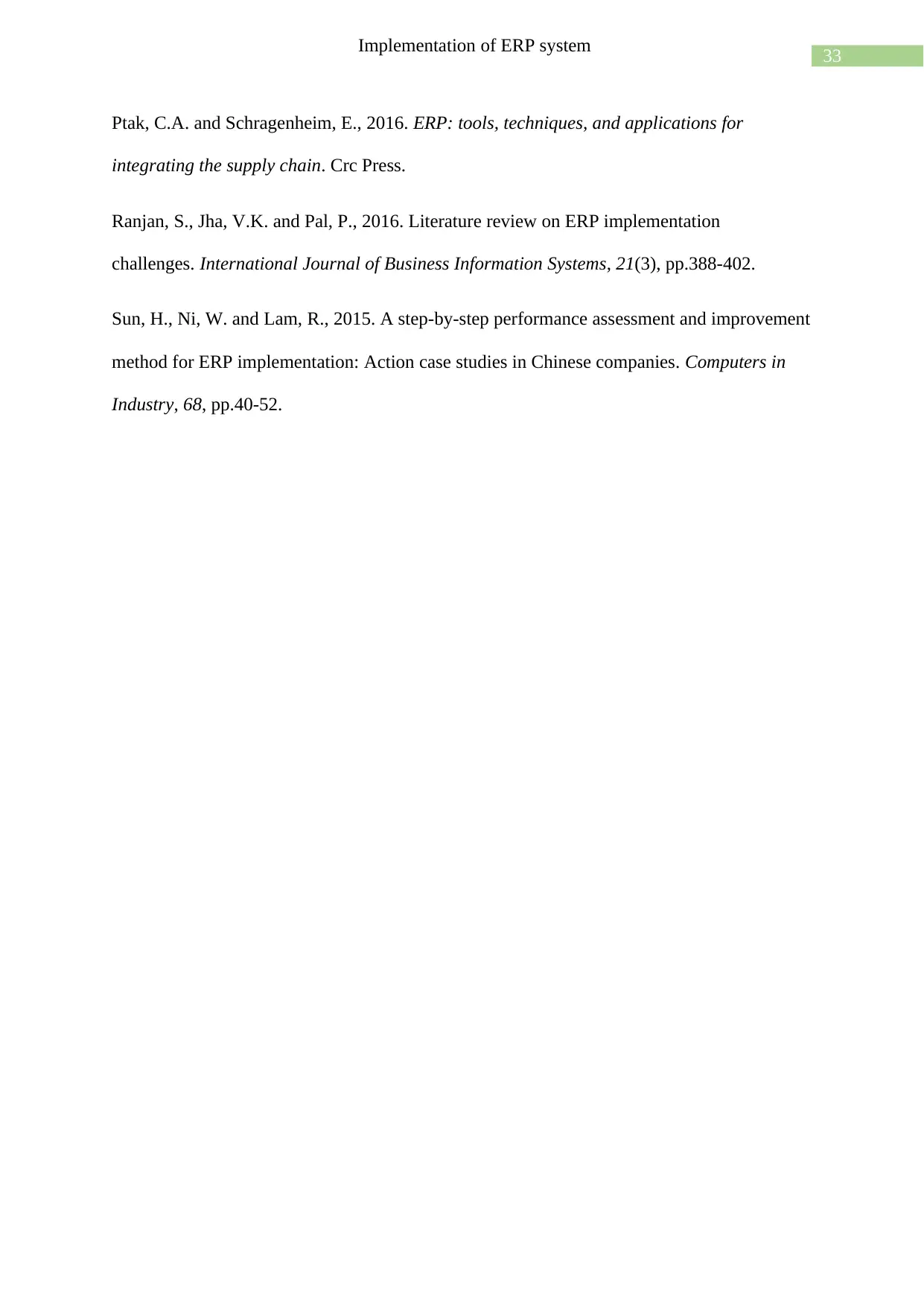
33
Implementation of ERP system
Ptak, C.A. and Schragenheim, E., 2016. ERP: tools, techniques, and applications for
integrating the supply chain. Crc Press.
Ranjan, S., Jha, V.K. and Pal, P., 2016. Literature review on ERP implementation
challenges. International Journal of Business Information Systems, 21(3), pp.388-402.
Sun, H., Ni, W. and Lam, R., 2015. A step-by-step performance assessment and improvement
method for ERP implementation: Action case studies in Chinese companies. Computers in
Industry, 68, pp.40-52.
Implementation of ERP system
Ptak, C.A. and Schragenheim, E., 2016. ERP: tools, techniques, and applications for
integrating the supply chain. Crc Press.
Ranjan, S., Jha, V.K. and Pal, P., 2016. Literature review on ERP implementation
challenges. International Journal of Business Information Systems, 21(3), pp.388-402.
Sun, H., Ni, W. and Lam, R., 2015. A step-by-step performance assessment and improvement
method for ERP implementation: Action case studies in Chinese companies. Computers in
Industry, 68, pp.40-52.
1 out of 34
Your All-in-One AI-Powered Toolkit for Academic Success.
+13062052269
info@desklib.com
Available 24*7 on WhatsApp / Email
![[object Object]](/_next/static/media/star-bottom.7253800d.svg)
Unlock your academic potential
© 2024 | Zucol Services PVT LTD | All rights reserved.
